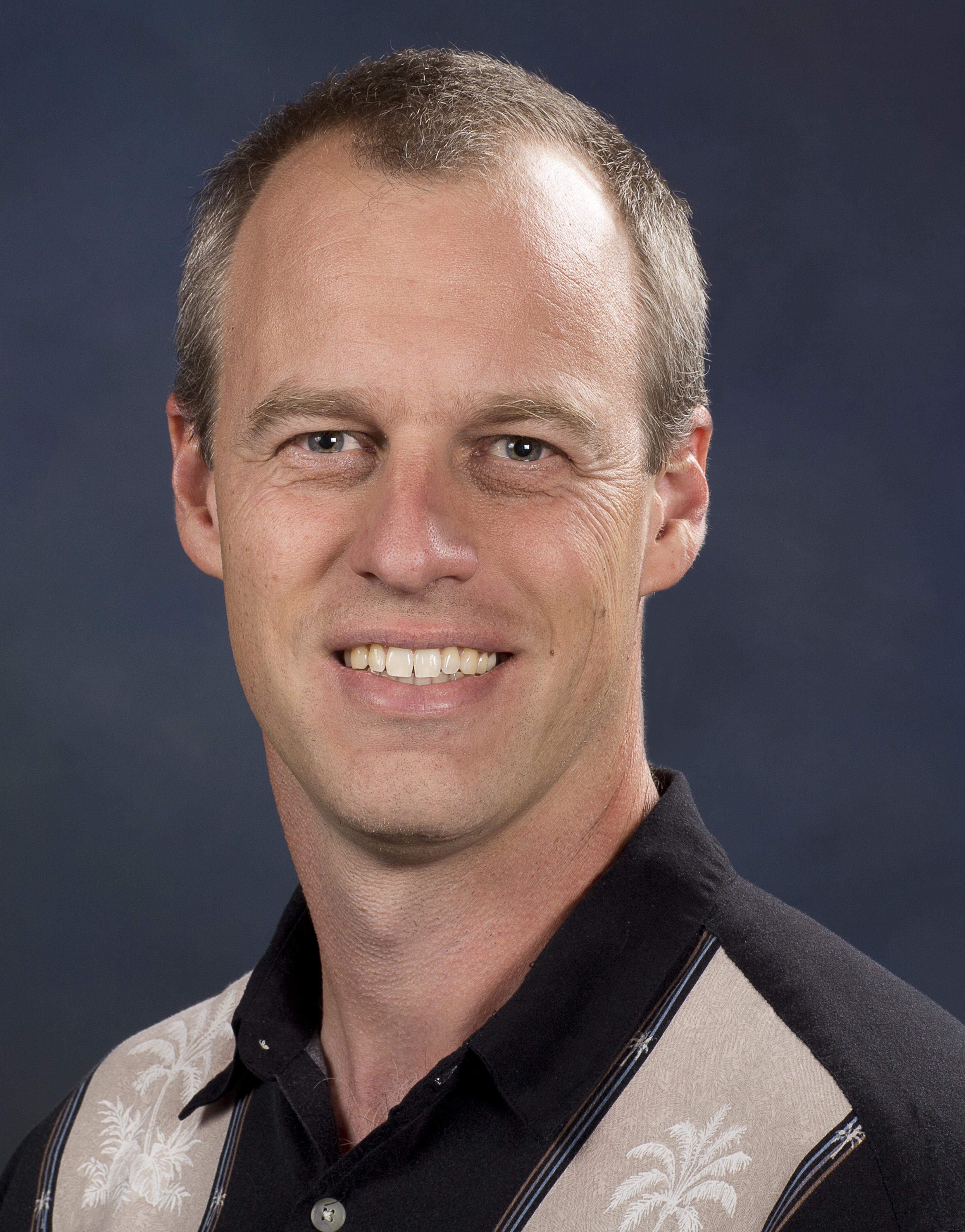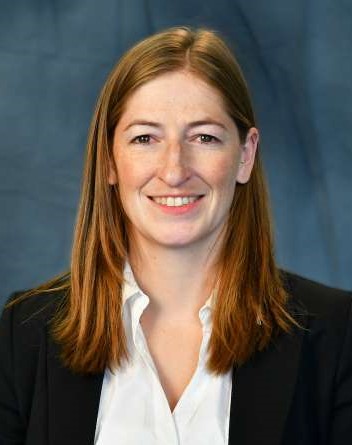IMS Virtual Library
IMS Virtual Library
2021 IMS Student Lecture Series
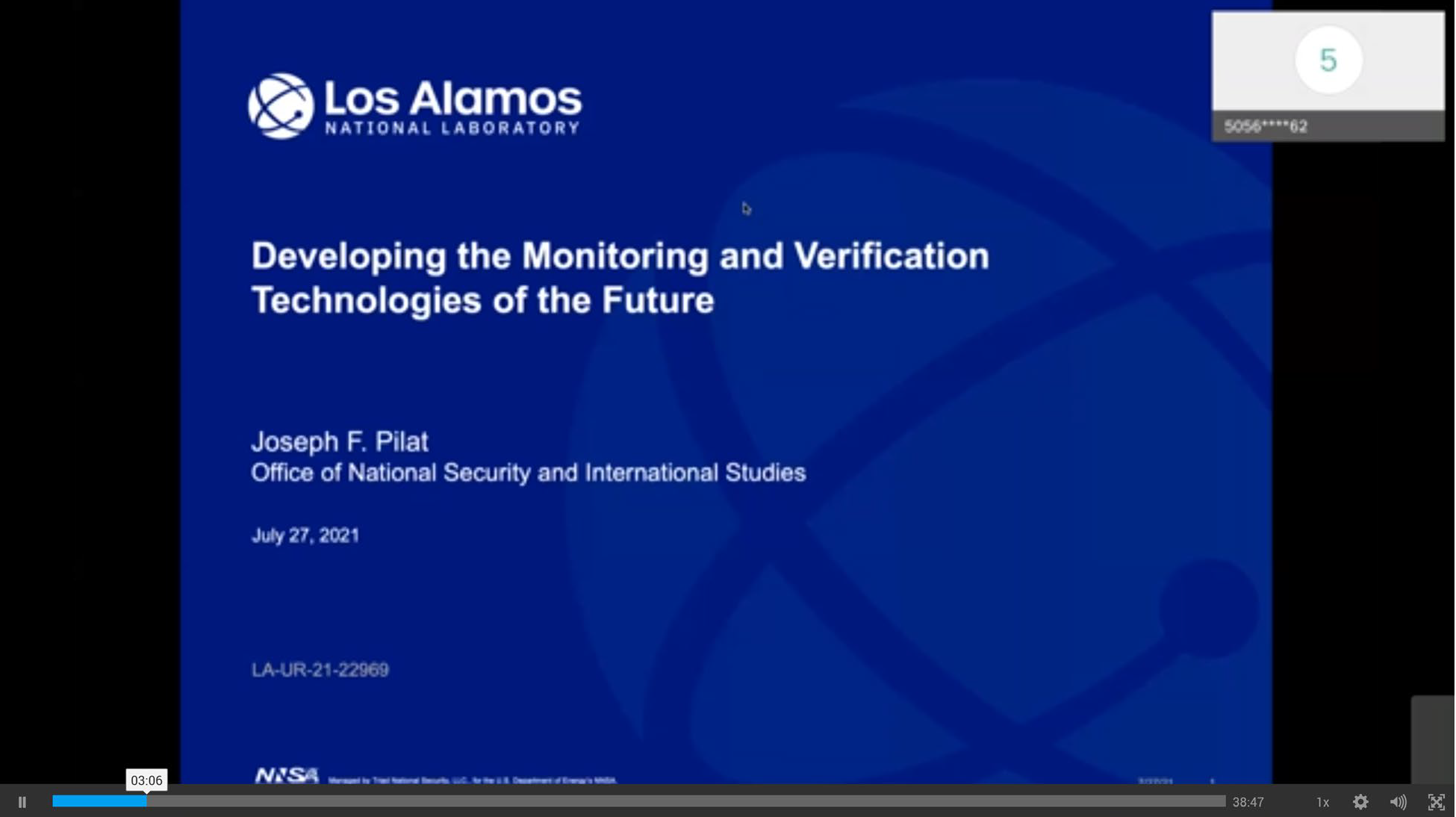 Joseph F. Pilat, Program Manager in the Office of National Security and International Studies, LANL, Developing the Monitoring and Verification Technologies of the Future, July 27 talk Video Link.
Joseph F. Pilat, Program Manager in the Office of National Security and International Studies, LANL, Developing the Monitoring and Verification Technologies of the Future, July 27 talk Video Link.
Biography: Joseph F. Pilat is a Program Manager in the National Security and International Studies Office of Los Alamos National Laboratory and a Global Fellow at the Woodrow Wilson International Center for Scholars where he co- directs the Nonproliferation Forum. He is also a member of the Proliferation Resistance and Physical Protection Working Group of the Generation IV International Forum and of the Steering Committee of the University of California's Institute on Conflict and Cooperation. Dr. Pilat served as representative of the Secretary of Defense to the Fourth Review Conference of the Nuclear Non-Proliferation Treaty (NPT), and as senior adviser to the US Delegation at the 1995 NPT Review and Extension Conference. He also served as representative of the Secretary of Defense to the Open Skies negotiations. He has been Special Assistant and Assistant for Nonproliferation Policy in the Office of the Deputy Assistant Secretary of Defense for Negotiations Policy, a Senior Research Associate in the Congressional Research Service and a Research Associate at the International Institute for Strategic Studies. Dr. Pilat has taught in the Department of Government at Cornell University and the College of William and Mary, and in the Department of History at Georgetown University. He has been a Senior Associate Member of St. Antony’s College, University of Oxford, a Visiting Fellow at Cornell’s Peace Studies Program and a Philip E. Mosely Fellow at the Center for Strategic and International Studies. Dr. Pilat has lectured widely at academic and policy institutions, including Harvard University, Princeton University, Stanford University, the Massachusetts Institute of Technology, UC-Berkeley, UCLA, the National Defense University, the Naval Postgraduate School, the American Association for the Advancement of Science, the National Academy of Sciences, the Monterey Institute for International Studies, the Institute for Defense Analysis, the RAND Corporation, McGill University, Dalhousie University, the University of Oxford, King’s College London, the London School of Economics and Political Science, Imperial College, Chatham House, the Royal Society, the École Polytechnique, the Fondation pour la Recherche Stratégique, the Commissariat à l'Énergie Atomique, the Deutsche Gesellschaft für Auswärtiges Politik, the Stiftung Wissenschaft und Politik, Universität Wien, the Istituto Affari Internazionali, Università di Roma Tre, Accademia Nazionale dei Lincei, Stockholm University, the Stockholm International Peace Research Institute, the NATO Defence College, the Moscow State Institute for International Affairs, Jawaharlal Nehru University, the Institute for Defense Studies and Analyses (New Delhi), the University of Tokyo, Keio University, the National Institute for Defense Studies (Tokyo), Peking University and Fudan University. He has written numerous articles and opinion pieces for US and European scholarly journals and newspapers, and is the author or editor of a number of books, including Ecological Politics: The Rise of the Green Movement (1980), The Nonproliferation Predicament (1985), Atoms for Peace: An Analysis after Thirty Years (1985), The Nuclear Suppliers and Nonproliferation: International Policy Choices (1985), Beyond 1995: The Future of the NPT Regime (1990), 1995: A New Beginning for the NPT? (1995); Atoms for Peace: A Future after Fifty Years? (2007); the Routledge Handbook on Nuclear Proliferation and Policy (2015); and The Politics of Weapons Inspections (2017).
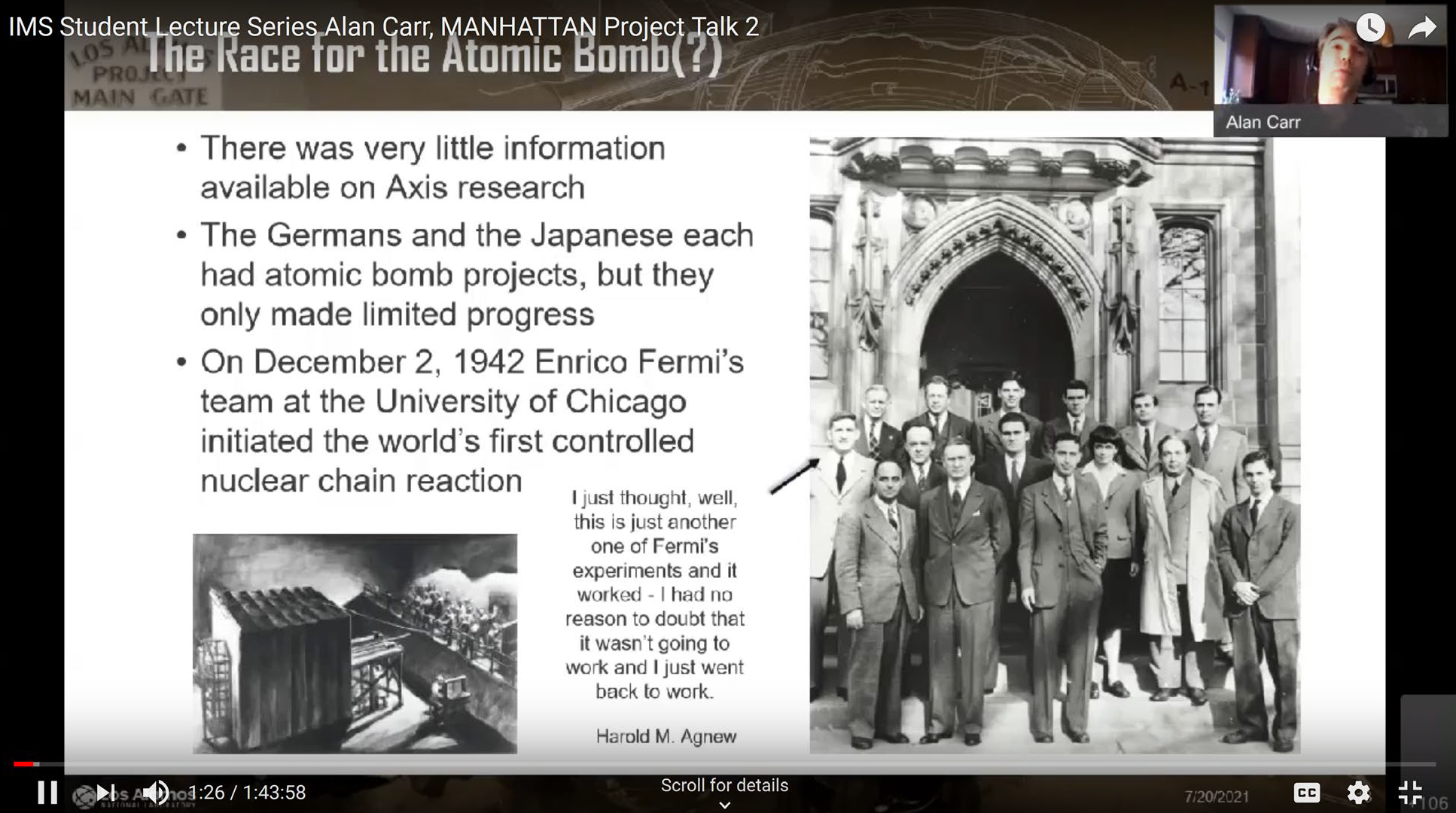 Alan Carr, Senior Historian/Program Manager WRS-SIS: Secure Information Services, MANHATTAN: The View from Los Alamos of History’s Most Secret Project, July 19 and 20, 2021, Talk Part I video link and Part II, video link, WebEx.
Alan Carr, Senior Historian/Program Manager WRS-SIS: Secure Information Services, MANHATTAN: The View from Los Alamos of History’s Most Secret Project, July 19 and 20, 2021, Talk Part I video link and Part II, video link, WebEx.
Abstract: In August 1942, the Manhattan Project was formally established. Its mission: build an entirely reliable atomic bomb as quickly as possible. It's been estimated that half a million people worked on the project in some capacity at one point or another during the war at installations all over the country. The three main sites were Oak Ridge, Hanford and Los Alamos: MANHATTAN tells the story of the project from the Los Alamos perspective. Led by J. Robert Oppenheimer, the Los Alamos technical staff of approximately 1700 employees designed, built, tested and helped deliver the world's first nuclear weapons in combat only 27 months after the Laboratory held its first, major technical conference. Atomic bombs helped bring history's deadliest conflict to a victorious conclusion, but not before 60-80 million people had been killed worldwide.
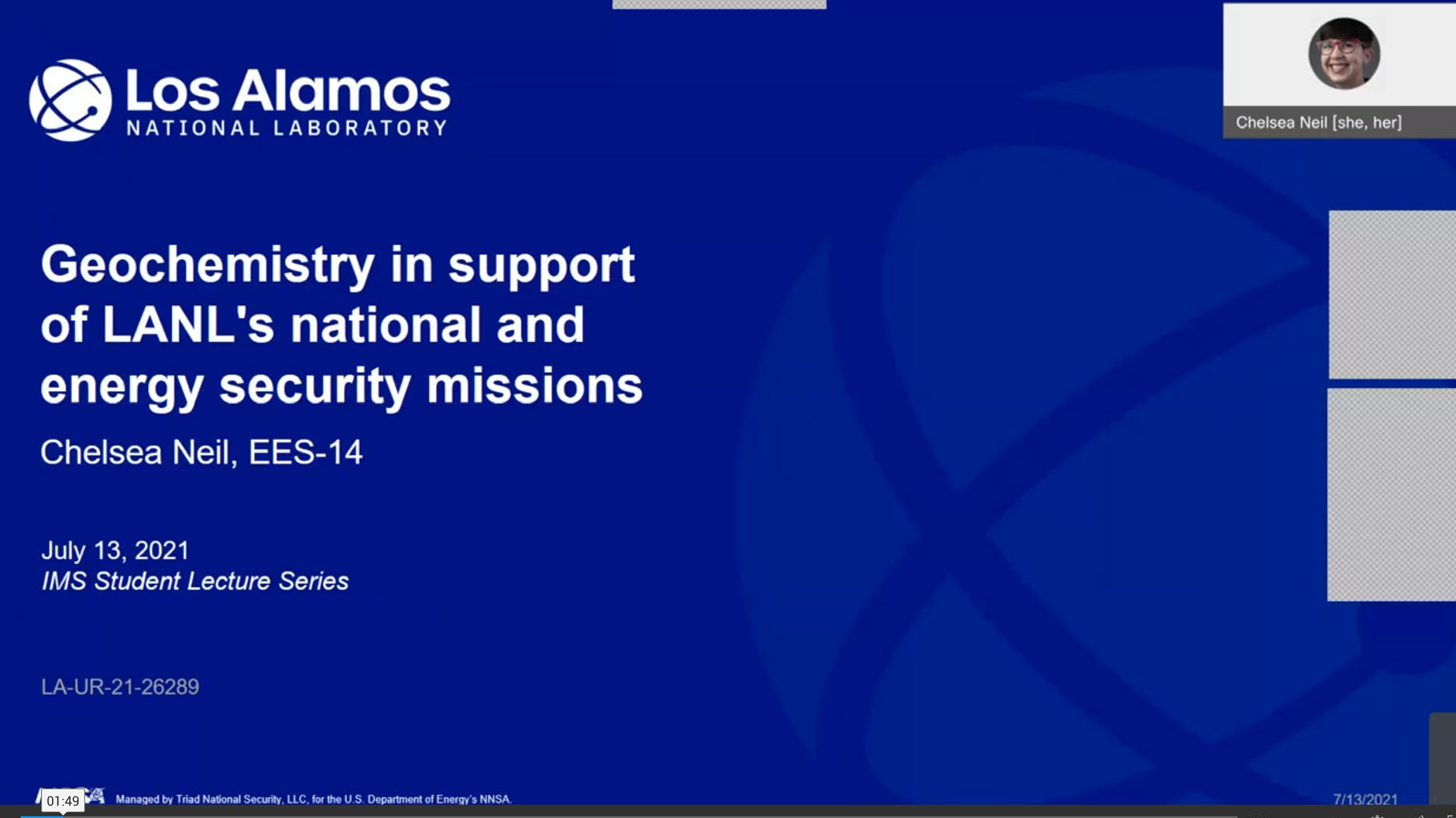 Chelsea Wren Neil, EES-14, Earth System Observations, LANL, Geochemistry in support of LANL's national and energy security missions, July 13, 2021 talk, video link.
Chelsea Wren Neil, EES-14, Earth System Observations, LANL, Geochemistry in support of LANL's national and energy security missions, July 13, 2021 talk, video link.
Abstract: Understanding subsurface geochemistry and transport is key in many mission-critical areas at LANL, including global and energy security. In this talk, I will give an overview of my laboratory work related to several ongoing projects, spanning from fission product subsurface transport for nuclear event identification to in situ observation of hydrocarbon fluid behavior in shale nanopores at high pressures. This research leverages unique LANL capabilities and expertise within the Earth and Environmental Sciences Division, as well as external collaborations, to meet project goals. Funding for these projects includes programs such as NA-22 and DOE-FE, LDRD, and industry CRADAs.
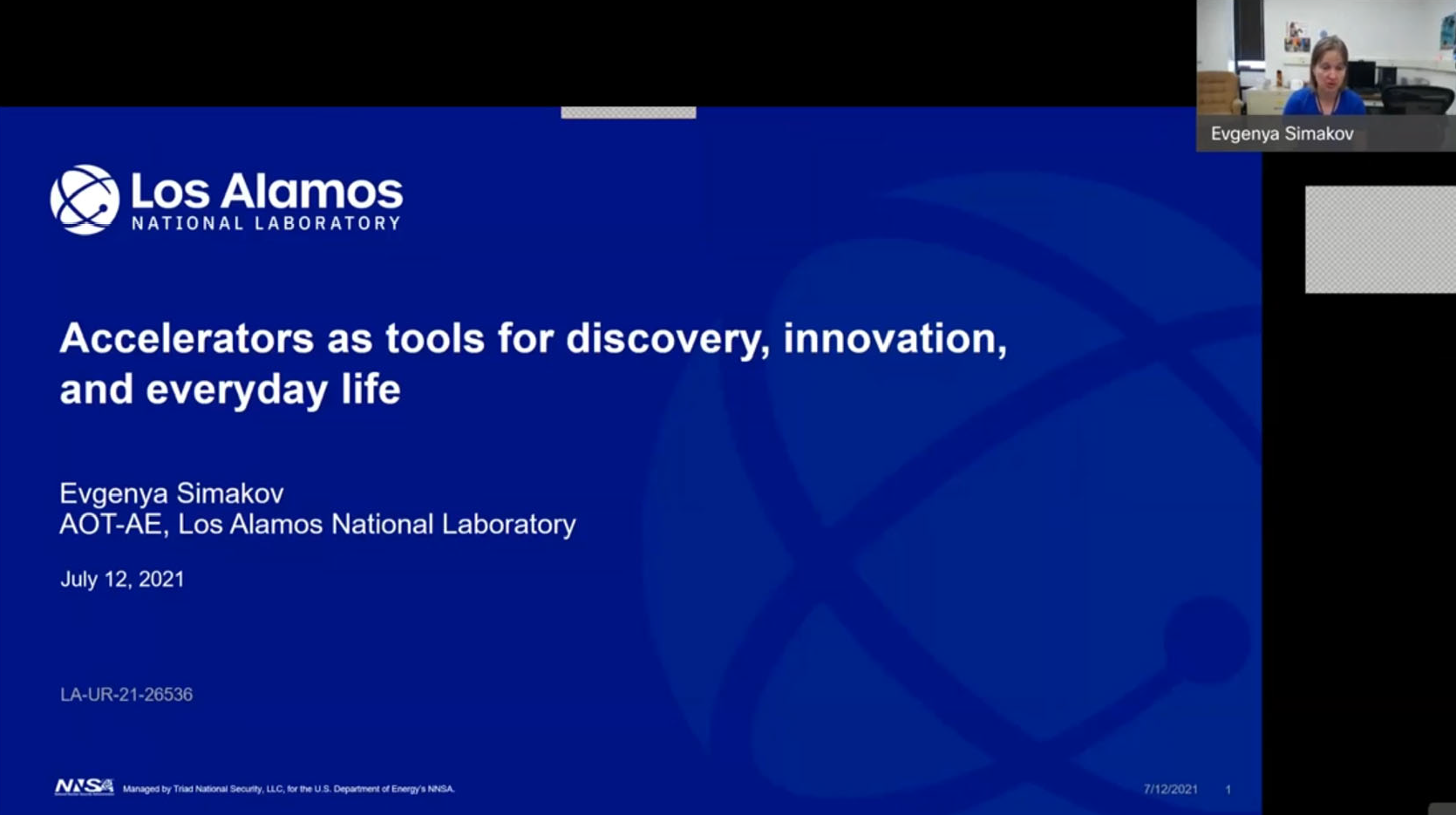 Evgenya Simakov, AOT-AE, Accelerators & Electrodynamics, LANL, Accelerators as tools for discovery, innovation, and everyday life, July 12, 2021 talk, video link.
Evgenya Simakov, AOT-AE, Accelerators & Electrodynamics, LANL, Accelerators as tools for discovery, innovation, and everyday life, July 12, 2021 talk, video link.
Abstract: A particle accelerator is an instrument that produces a directional stream of electrically charged particles, usually electrons or protons and boosts the energy of this beam. Particle beams are used for many kinds of research, but also for medical and industrial applications. Large particle accelerator facilities such as the Large Hardron Collider (LHC) operate in many National Laboratories in the United States and around the world. However, the majority of operating accelerators are neither big nor famous. About 10,000 cancer patients are treated every day in the United States with beams for accelerators. Accelerators produce short-lived radioisotopes that are used in over 10 million diagnostic medical procedures and 100 million laboratory tests every year. The multi-billion-dollar semiconductor industry relies on ion beams from accelerators to add atoms in semiconductors. Lithography with intense beams etches microchips for semiconductor devices. Accelerators are used for accurate nondestructive dating of archeological samples and art objects, for unraveling DNA structure, and provide promising potential avenues towards solving energy problems. At Los Alamos National Laboratory we use accelerators, big and small, to solve National Security issues. This talk will introduce the basic principles of particle acceleration and explain how accelerators work. It will also give an overview of many applications of accelerators.
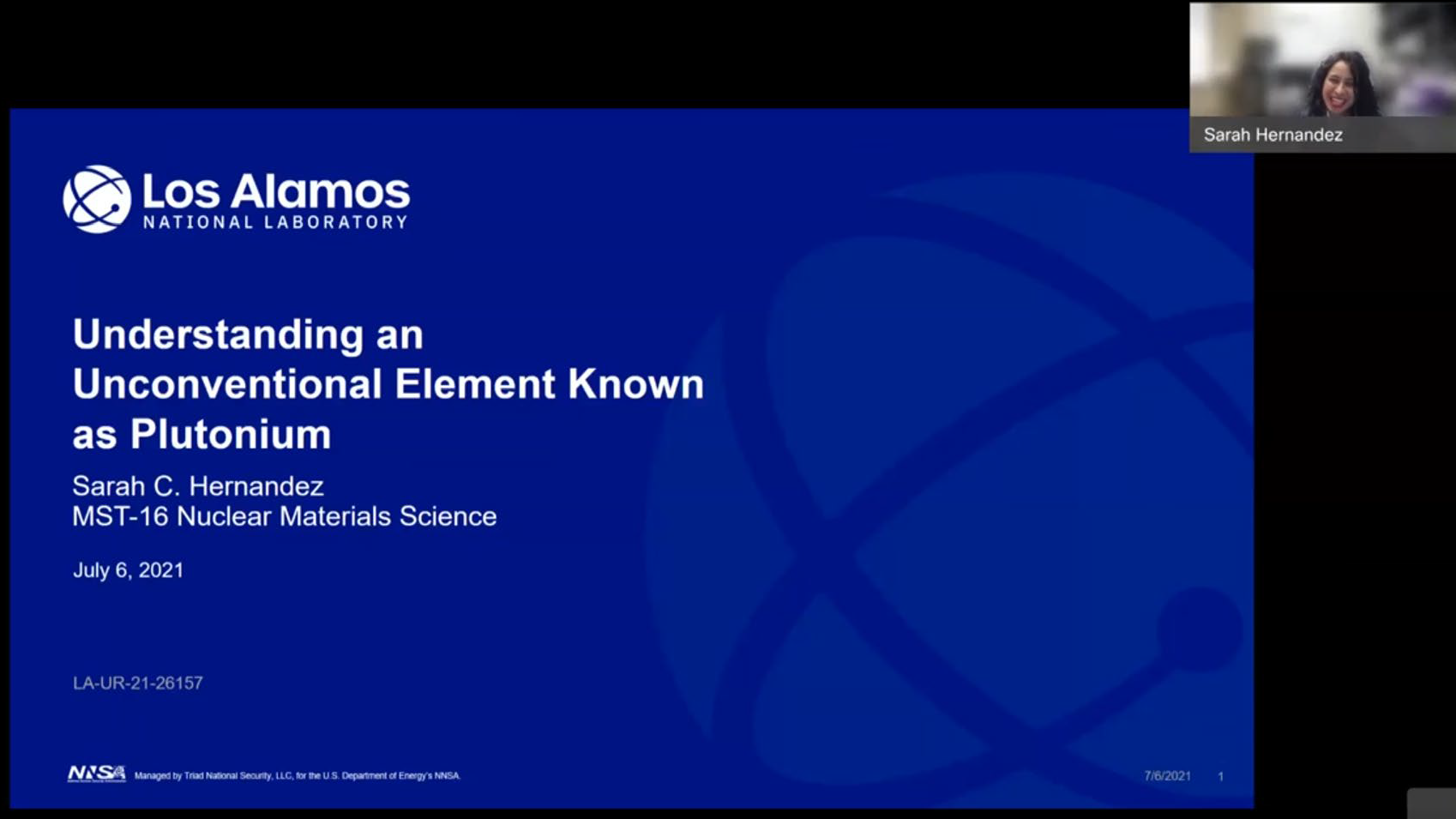 Sarah C. Hernandez, MST-16 Nuclear Materials Science, LANL, Understanding an Unconventional Element Known as Plutonium, July 6, 2021 talk, video link.
Sarah C. Hernandez, MST-16 Nuclear Materials Science, LANL, Understanding an Unconventional Element Known as Plutonium, July 6, 2021 talk, video link.
Abstract: Plutonium (Pu) has been referred to as “a physicist’s dream but an engineer’s nightmare,” and the most complex element in the periodic table. This is due to the fact that Pu happens to be located at the boundary of delocalized and localized electrons in the actinide series. Unusual behavior of Pu includes a room temperature monoclinic phase, six solid-state phases upon heating, a low melting temperature of 900K, extreme reactivity, unexpected behavior due to self-irradiation damage, and phases that experience a negative thermal expansion. I will discuss my quest, beginning as a PhD graduate student, in understanding such an unconventional element that defines Los Alamos National Laboratory as the Nation’s Plutonium Center of R&D Excellence.
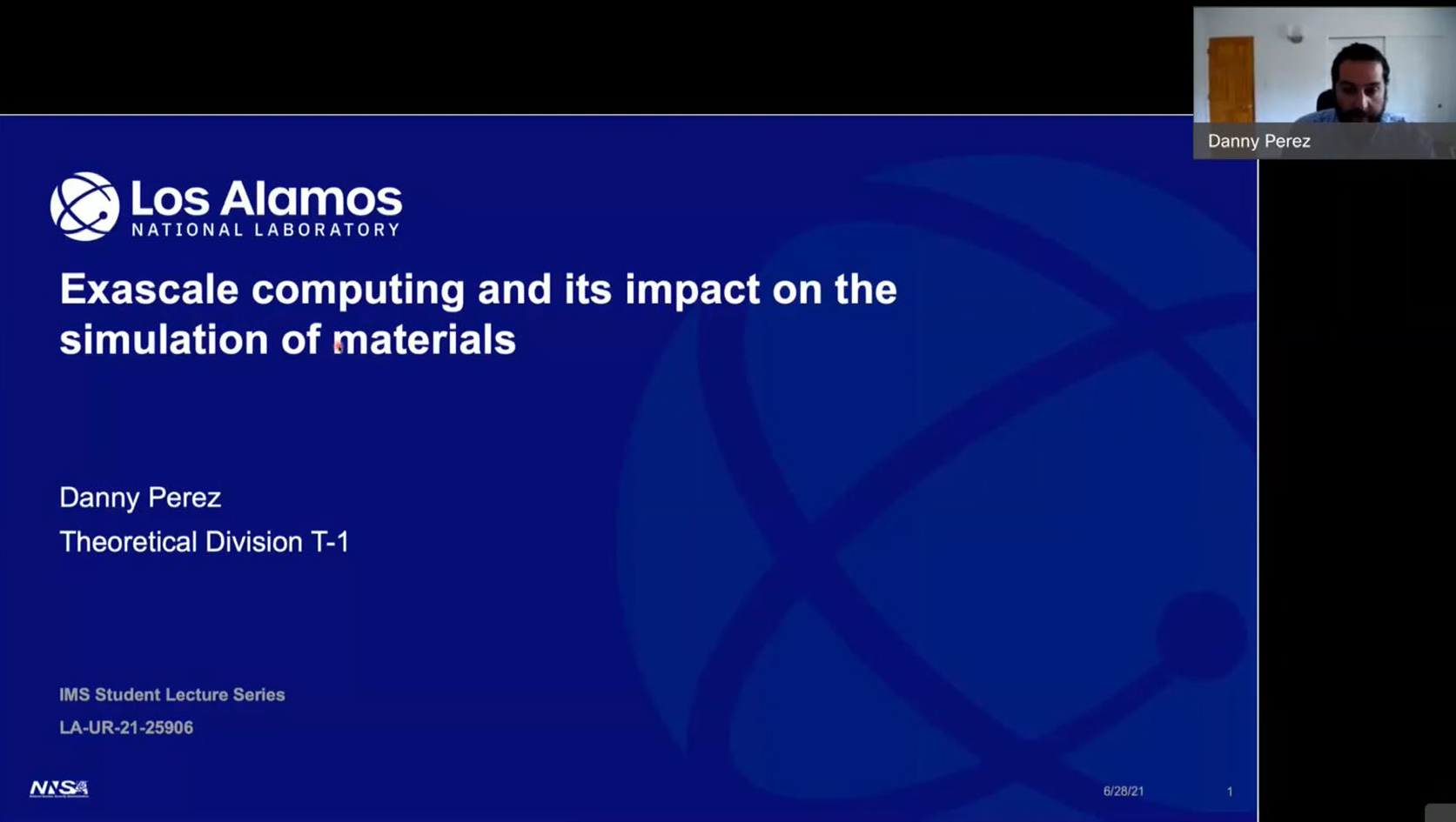 Danny Perez, T-1, Physics and Chemistry of Materials, LANL, Exascale computing and its impact on the simulation of materials, June 28, 2021 talk, video link, WebEx.
Danny Perez, T-1, Physics and Chemistry of Materials, LANL, Exascale computing and its impact on the simulation of materials, June 28, 2021 talk, video link, WebEx.
Abstract: Thirteen years after entering the petascale era with LANL’s Roadrunner, we now find ourselves at the dawn of the exascale era. Exascale computers, which will deliver in excess of 1018 operations per second, will offer a unique opportunity to further the scale and fidelity of a wide range of numerical simulations. However, efficiently exploiting such massively-parallel resources also presents significant challenges. I will discuss these opportunities and challenges from the point of view of atomistic simulations of materials, especially with methods such as molecular dynamics. I will especially focus on the fact that, while larger computers offer a natural path to increasing the size and accuracy of simulations, is it typically much harder to increase simulation times, which is often key to understand the behavior of materials in operation. I will present our strategy to address this problem and discuss future perspectives.
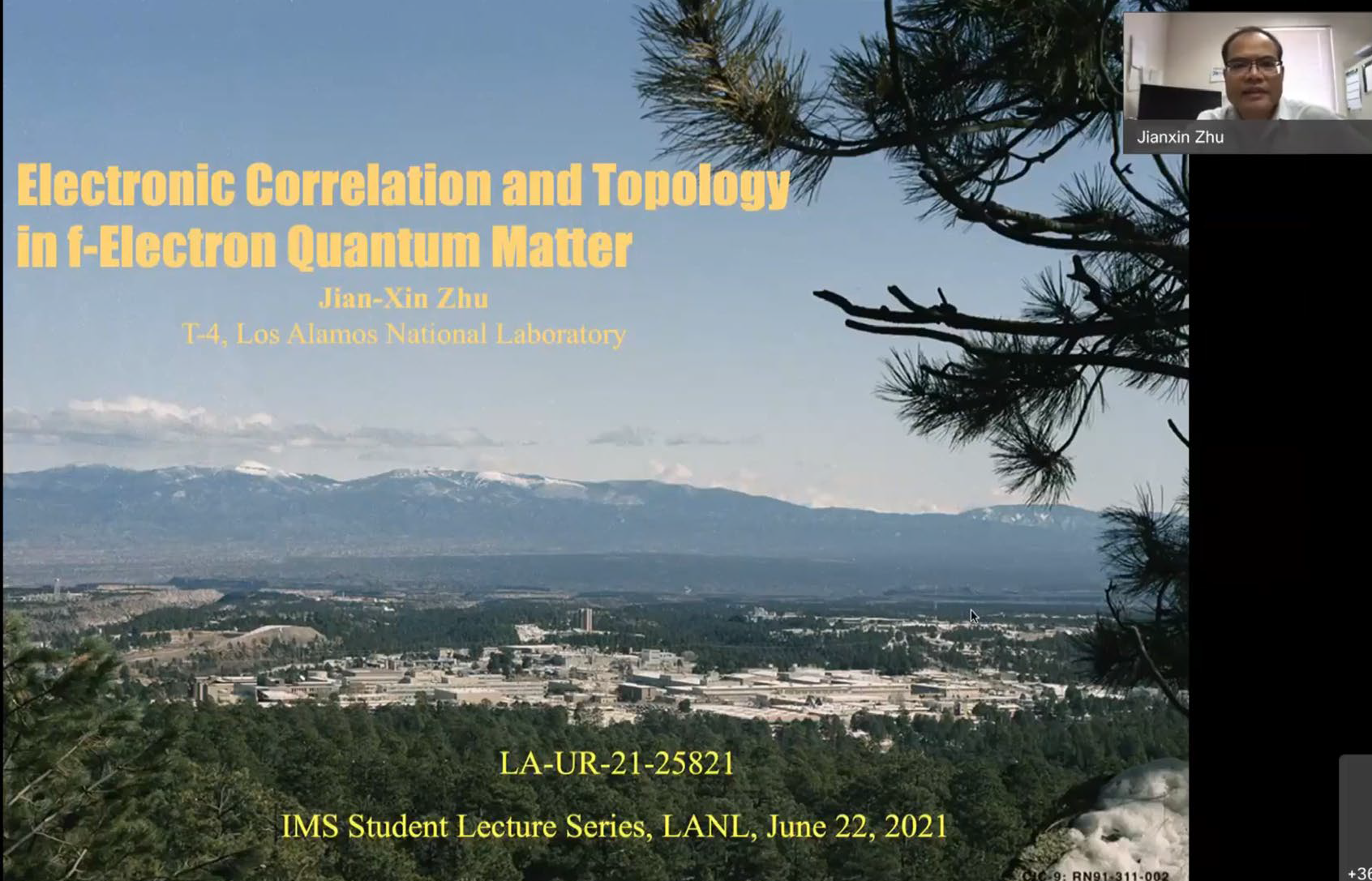 Jian-Xin Zhu, T-4 Phys of Condensed Matter & Complex Sys., Electronic Correlation and Topology in f-Electron Quantum Matter, June 22, 2021 talk, video link, WebEx.
Jian-Xin Zhu, T-4 Phys of Condensed Matter & Complex Sys., Electronic Correlation and Topology in f-Electron Quantum Matter, June 22, 2021 talk, video link, WebEx.
Abstract: In recent years there has been a surge of interest in quantum materials with topologically protected properties, which are robust against disorder effects. Interesting examples are topological insulators and three-dimensional Weyl metals. Electronic structure has played an important role in the exotic properties of these materials. The f-electron materials are unique with their strong correlations and large spin-orbit coupling, serving as good material systems for interplay between electronic correlation and topology. Here I will present a brief overview of recent studies of electronic structure and its topology in both rare-earth and actinide f-electron materials. The theoretical challenges and opportunities in dealing with the interplay will also be discussed.
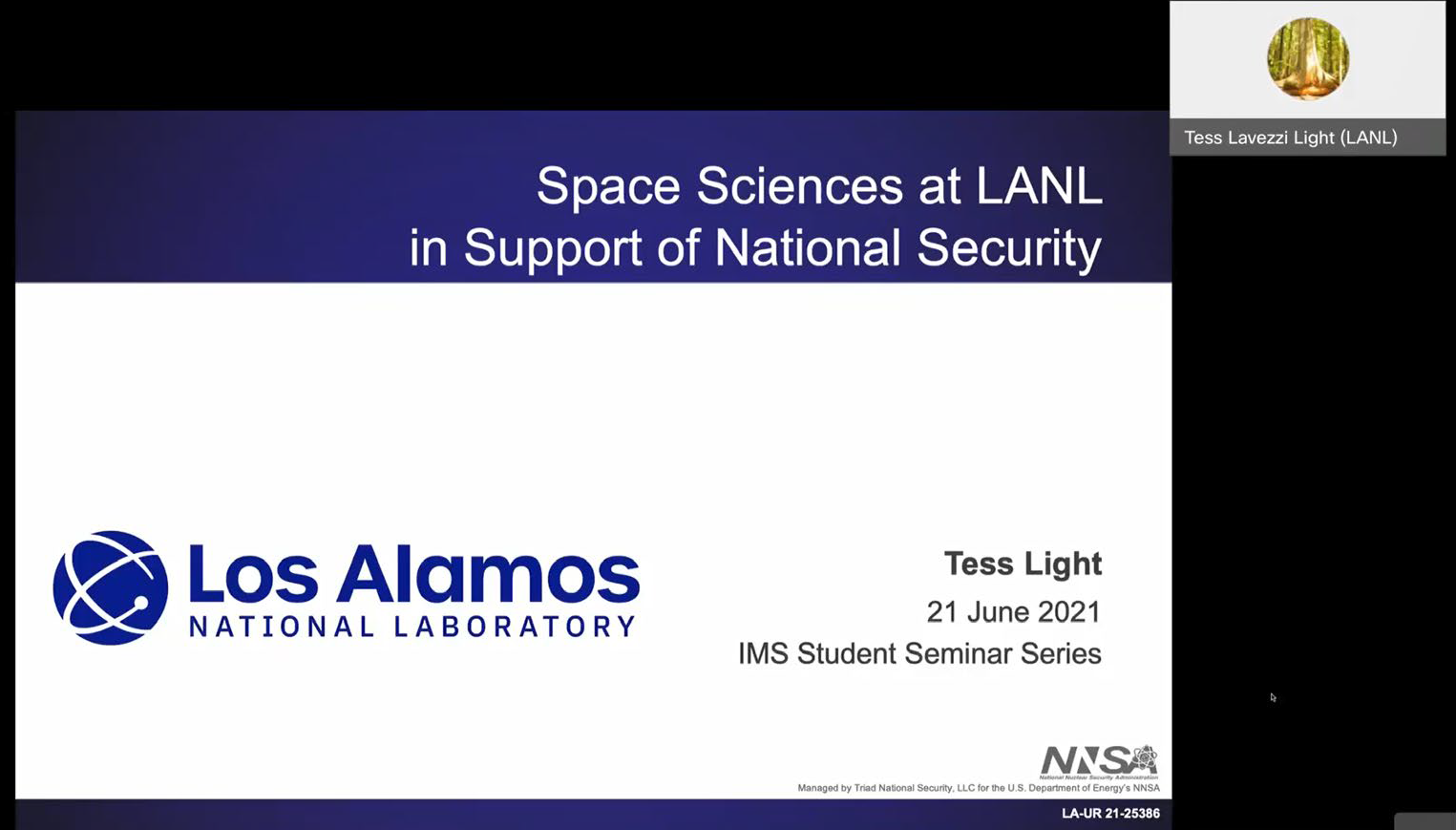 Tess Lavezzi Light, International and Space Research, LANL, Space Sciences at LANL in support of national security, June 21, 2021 talk, video link, WebEx
Tess Lavezzi Light, International and Space Research, LANL, Space Sciences at LANL in support of national security, June 21, 2021 talk, video link, WebEx
Abstract: Since the 1960s, Los Alamos has developed, launched and operated space-based sensors in support of global nuclear threat monitoring applications. In addition to this national security mission, the Laboratory flies cube-sats and contributes to NASA missions, performing research on lightning, the space environment, the Earth’s atmosphere, and more. Overall, the Laboratory has flown approximately 400 instruments carrying over 1400 sensors on more than 200 total space vehicles.

Franz J. Freibert, Director, G.T. Seaborg Institute, LANL, Glenn T. Seaborg, the US DOE Complex Actinide Mission, and the Seaborg Institute Network, June 8, 2021 talk, video link.
Abstract: In his lifetime, Glenn T. Seaborg led efforts of profound early discoveries and technological advancements in nuclear chemistry, which impacted scientific and global political history. These include but are not limited to isolating and identifying plutonium and nine other new elements, scaling up plutonium production by a billion times in support of the Manhattan Project and identifying the “Actinide Concept”. Seaborg recognized the significant importance of scientific education to generations of scientists, engineers and technologists to address future challenges. The network of Seaborg Institutes throughout the US is his legacy supporting broad topics in actinide science, technology, education and research; and positively influencing the international actinide community.
2021 IMS Sponsored Lecture Series
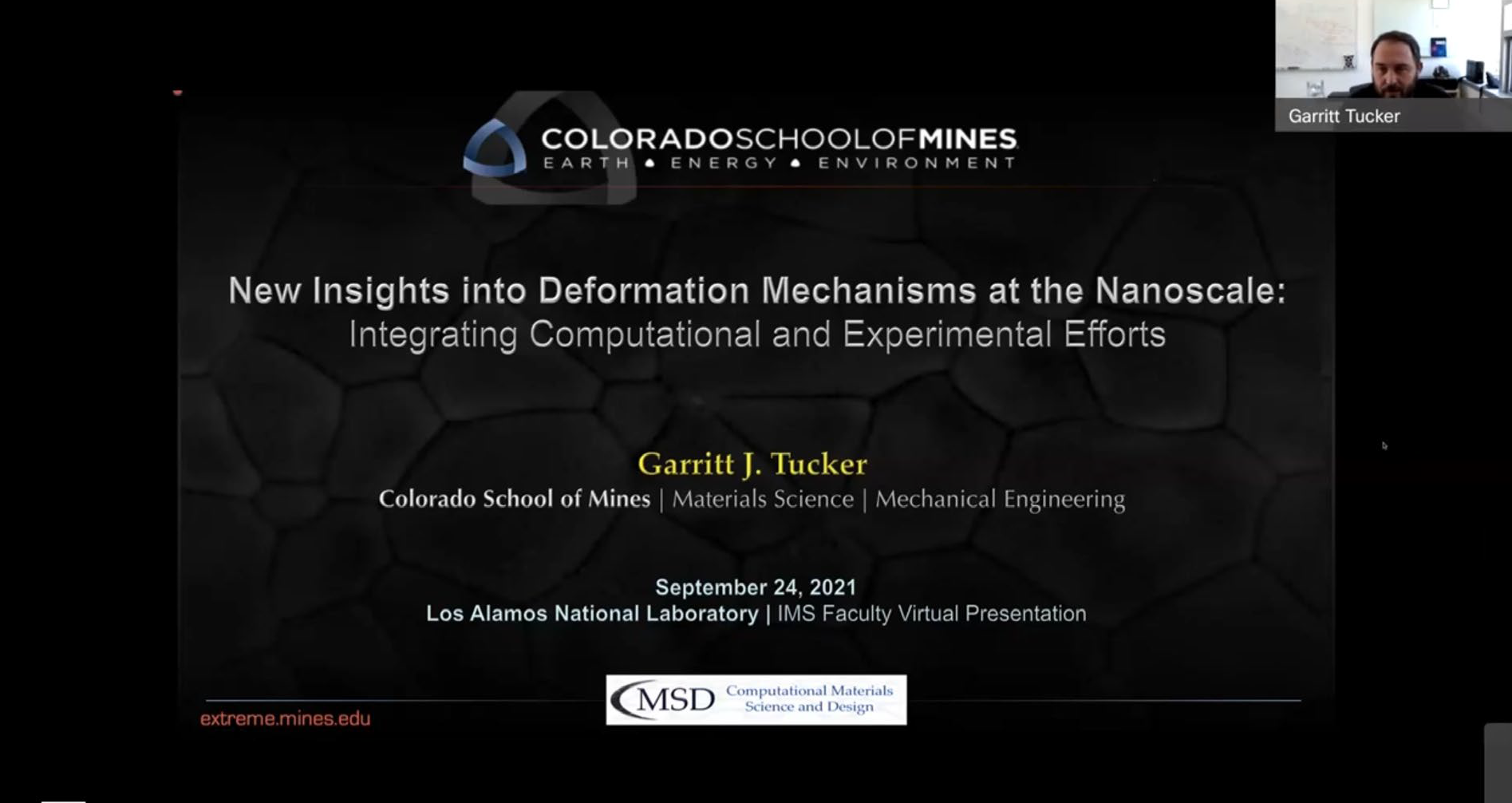 Garritt J. Tucker, Associate Professor, Colorado School of Mines, Department of Mechanical Engineering/Materials Science Program, New Insights into Deformation Mechanisms at the Nanoscale: Integrating Computational and Experimental Efforts, September 24, 2021, video link.
Garritt J. Tucker, Associate Professor, Colorado School of Mines, Department of Mechanical Engineering/Materials Science Program, New Insights into Deformation Mechanisms at the Nanoscale: Integrating Computational and Experimental Efforts, September 24, 2021, video link.
Abstract: Tuning the mechanical properties and thermomechanical stability of materials often depends upon controlling the competition/cooperation between fundamental material deformation modes. As materials are increasingly engineered more precisely for target applications and environments, such as in the development of nanostructured materials, our understanding of these deformation modes, or mechanisms, must also become more robust. However, our current understanding of both individual and collective mechanistic effects on mechanical behavior of a material remains limited, or qualitative at best in most cases. New approaches and tools are emerging that will help to understand the potentially complex landscape of operative deformation mechanisms at the nanoscale. Here, we overview some recent efforts to utilize new approaches to characterize and quantify the role of key deformation mechanisms in nanostructured materials. In nanocrystalline alloys, we employ a set of microscale continuum metrics along with large-scale Molecular Dynamics to unravel the competition of dislocation and interfacial-mediated plasticity. The computational work uncovers key considerations when designing new alloy systems for achieving maximum strength and thermomechanical stability, and help to explain trends observed in the experimental literature regarding the role of grain size and solute segregation. In MAX phase ceramics, a long-standing question has remained regarding the origins of deformation and kinking that lead to failure and potentially high strain energy absorption. MAX phases have been identified as kinking non-linear elastic materials, a property theorized to be purely a function of the nanolayered architecture and reversible strain accommodation therein. Our work using atomistic models and simulations, combined with multi-scale characterization, highlight the origins of deformation in MAX phase materials. We utilize a newly developed interatomic potential to capture the nucleation and evolution of unique deformation mechanisms whose structure and operation are inherently linked to the nanoscale layered architecture of MAX phases.
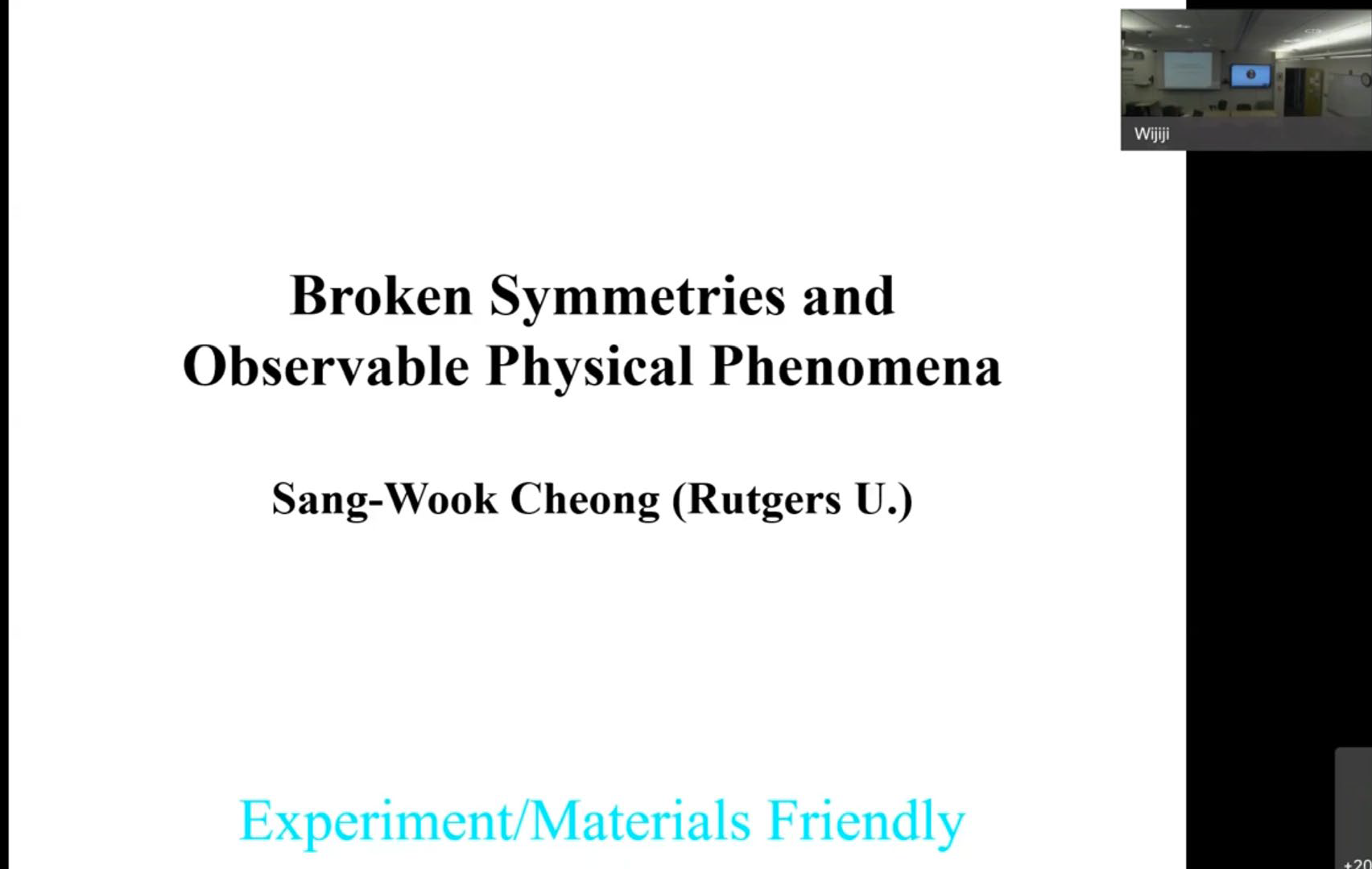 Sang-Wook Cheong, Rutgers University, Lecture Series: Broken Symmetries and Observable Physical Phenomena, Day 1, August, 9, 2021, video link. Day 2 video is not available.
Sang-Wook Cheong, Rutgers University, Lecture Series: Broken Symmetries and Observable Physical Phenomena, Day 1, August, 9, 2021, video link. Day 2 video is not available.
Abstract: The act of breaking symmetry spontaneously leads to phase transitions, and various observables or observable physical phenomena can be directly associated with broken symmetries. Symmetry has been considered all the time in physics, but often in a fragmentary way. Herein, we consider broken symmetries in a systematic, unified, and experiment-friendly manner. We first define one-dimensional (1D) objects from a symmetry consideration, and then show that eight kinds of 1D objects (four; vector-like, the other four; director-like) and their dot/cross products are defined in terms of symmetry. The dot products form a Z2xZ2xZ2 group with Abelian additive operation, and the cross products form a Z2xZ2 group with Abelian additive operation or Q8, a non-abelian group of order eight, depending on their signs. Those 1D objects are associated with characteristic physical phenomena, and when a 3D system has identical or lower (but not higher) symmetries than (the so-called SOS, symmetry operation symmetry, with) an 1D object with particular phenomena, the 3D system can exhibit the phenomena. This SOS approach often works because numerous physical observations are associated with 1D objects such as magnetization, electric polarization, unidirectional electric current flow or unidirectional light propagation. The power of the SOS approach lies in providing simple and physically transparent views of otherwise unintuitive phenomena in complex materials. In turn, this approach can be leveraged to identify new materials that exhibit potentially desired properties as well as new phenomena in known materials.
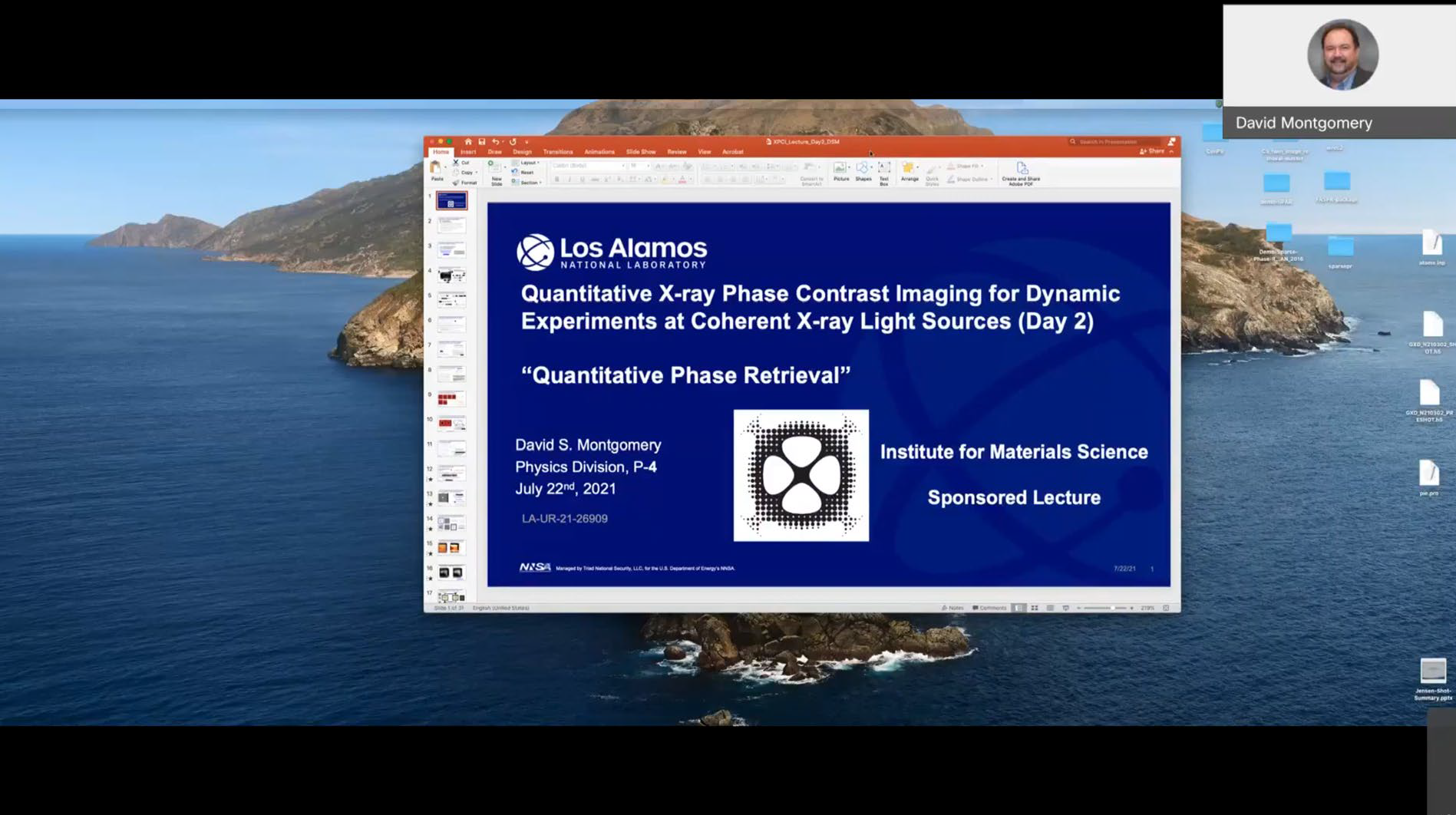 David S. Montgomery, P-4: Thermonuclear Plasma Physics, LANL, Lecture Series: Quantitative X-ray Phase Contrast Imaging for Dynamic Experiments at Coherent X-ray Light Sources, Day 1 - X-ray Phase Contrast Imaging, Overview, Theory, Applications, July 20, 2021, Video link to come. Day 2 - Quantitative Phase Retrieval July 22, 2021, Video Link
David S. Montgomery, P-4: Thermonuclear Plasma Physics, LANL, Lecture Series: Quantitative X-ray Phase Contrast Imaging for Dynamic Experiments at Coherent X-ray Light Sources, Day 1 - X-ray Phase Contrast Imaging, Overview, Theory, Applications, July 20, 2021, Video link to come. Day 2 - Quantitative Phase Retrieval July 22, 2021, Video Link
Abstract: X-ray radiography has been used for several decades in dynamic experiments to measure material flow in extreme conditions via absorption of x-rays propagating through materials. Image contrast in traditional radiography is determined by the absorption coefficients and areal densities of the materials at a given x-ray wavelength, and often limits these measurements to materials with sufficiently high atomic numbers and density, while low-Z materials and small areal density variations are either completely transparent or not sufficiently visible in the image. Coherent x-ray sources, such as those found at synchrotrons and x-ray free-electron lasers, provide new opportunities for imaging dynamic experiments due to their high spatial and spectral coherence, high brightness and short temporal duration (<< 100 ps).
Phase sensitive techniques, such as x-ray phase contrast imaging (XPCI), rely on the overlap and interference of the x-rays due to spatial variations in their transmitted phase, and are enabled primarily by high spatial coherence of the x-ray source. Objects that are otherwise transparent to x-rays can be imaged with XPCI, and small variations in areal density become visible that would not be observable with traditional radiography. In this two day series of lectures, an overview of XPCI and image formation theory will be given, and current applications of this technique in shock physics, material dynamics, and high energy-density physics will be presented on Day 1. Related applications of neutron phase contrast imaging with cold neutron sources will also be presented. On Day 2, quantitative phase retrieval methods and algorithmic approaches will be presented, as well as example algorithms.
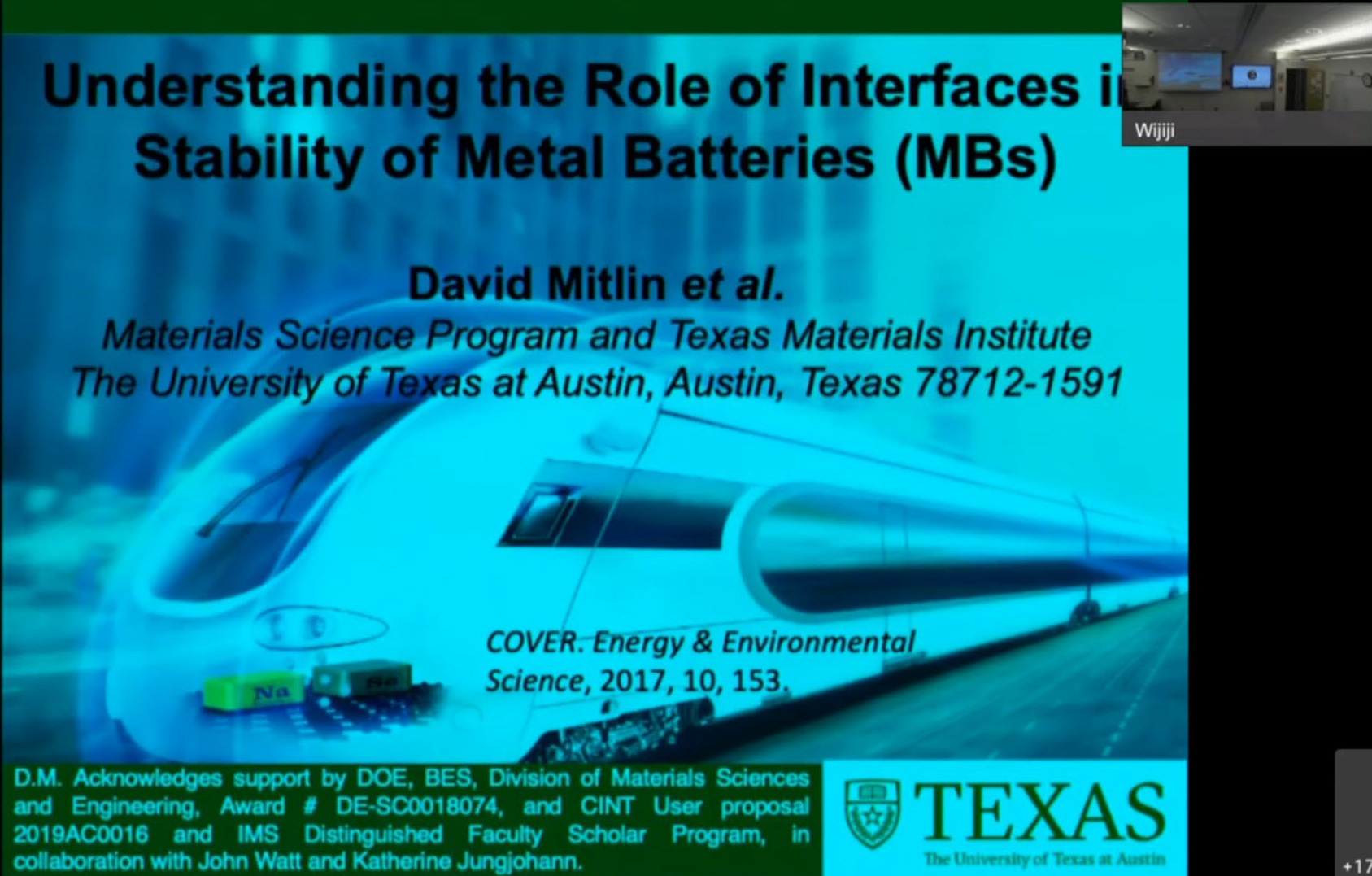 David Mitlin, Materials Science Program and Texas Materials Institute, The University of Texas at Austin, Microstructural Design Principles for Achieving Stable Electrochemical Interfaces for Metal Anodes, July 15, 2021 talk, video link, WebEx.
David Mitlin, Materials Science Program and Texas Materials Institute, The University of Texas at Austin, Microstructural Design Principles for Achieving Stable Electrochemical Interfaces for Metal Anodes, July 15, 2021 talk, video link, WebEx.
Abstract: Lithium metal battery systems (LMBs) are being sought as an ultimate replacement to LIBs, potentially increasing the cell energy by over fifty percent due to the high capacity and low voltage of the metal anode. Analogous improvement in energy is possible with sodium metal batteries (NMBs) and with potassium metal batteries (KMBs), where existing ion insertion anodes can be replaced by plating/stripping metal. However, in all three cases safety and performance are compromised by an unstable solid electrolyte interphase (SEI) that consumes metal ions and electrolyte, and ultimately leads to dendrites. This presentation provides a series of case studies derived from the group's LMB, NMB and KMB research on the microstructural design principles that provide for long-term cycling and fast-charge stability of metal anodes. The approaches may be categorized as the following: a) design of plating/stripping supports and templates with tuned geometry and functionality; b) design of secondary interlayers placed between the metal anode and the separator; and c) design of multifunctional hybrid separators to replace the conventional polymer separators employed with LIBs. It is demonstrated that despite appearing distinct, the efficacy of each in enabling electrochemical stability originates from three fundamental features that are directly interrelated. The wetting behavior of the electrolyte on the anode must be optimized, the wetting/stripping behavior of the metal anode on the current collector must be controlled, and a geometrically and chemically modified SEI must be established. Simultaneously achieving all three leads to stable plating/stripping, while missing even one leads to rapid dendrite growth. Cryogenic FIB cross sections and cryo-TEM are combined to yield new insight regarding film wetting behavior and early dendrite formation in optimized versus baseline specimens, analyzing growth in several representative electrolytes.
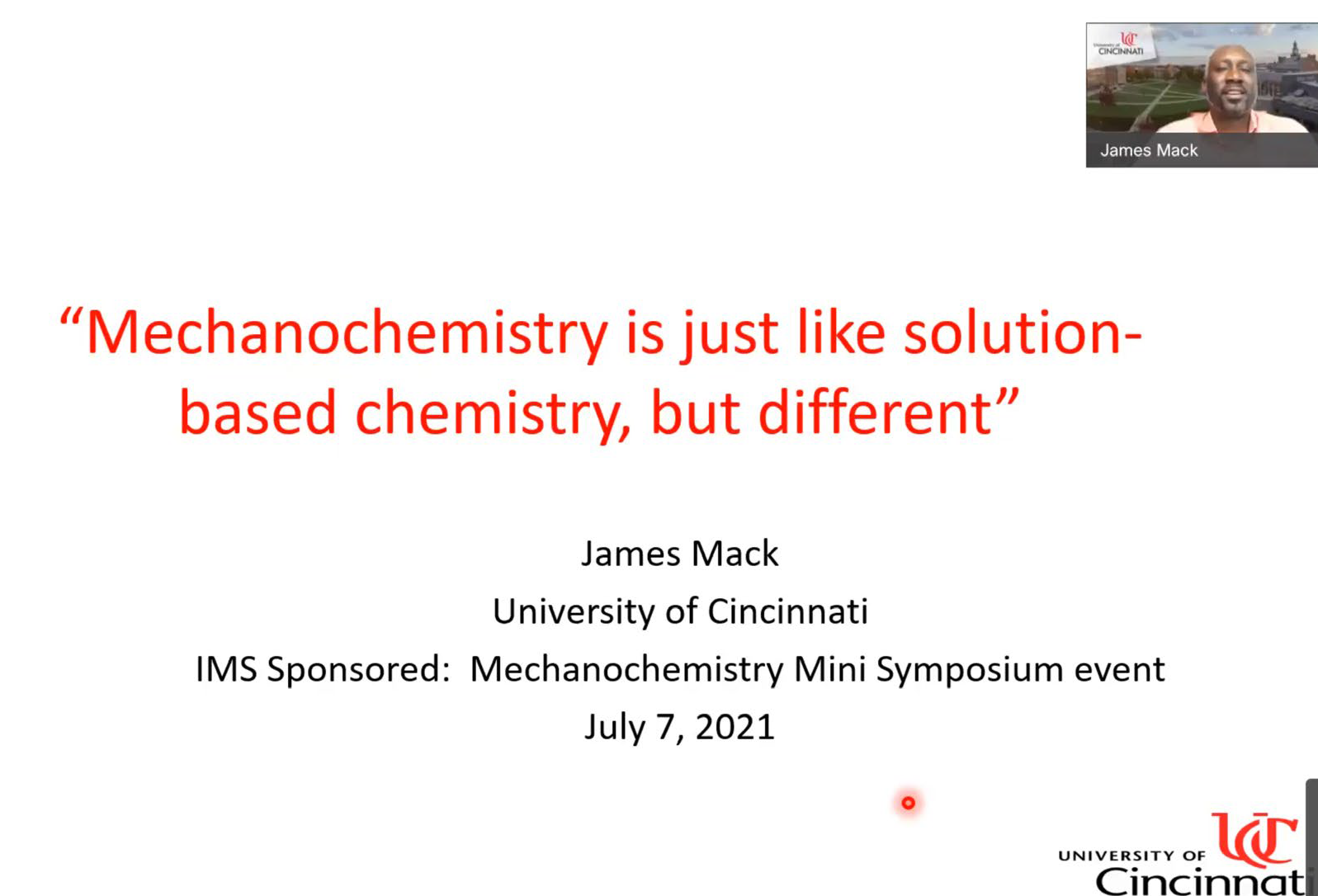 Mechanochemistry Mini-Symposium - Wednesday, July 7, 2021. Video Link for all talks. James Mack, Associate Dean of the Graduate School, Professor of Chemistry, University of Cincinnati, Mechanochemistry is just like solution-based chemistry, but different. Scott R. Daly, Associate Professor, Department of Chemistry, University of Iowa, Mechanochemical Synthesis and Separation of f-Element Borohydride Complexes. Adam A.L. Michalchuk, Federal Institute for Materials Research and Testing (BAM), Berlin, Germany, Shining a New Light on Mechano-Chemical Reactions.
Mechanochemistry Mini-Symposium - Wednesday, July 7, 2021. Video Link for all talks. James Mack, Associate Dean of the Graduate School, Professor of Chemistry, University of Cincinnati, Mechanochemistry is just like solution-based chemistry, but different. Scott R. Daly, Associate Professor, Department of Chemistry, University of Iowa, Mechanochemical Synthesis and Separation of f-Element Borohydride Complexes. Adam A.L. Michalchuk, Federal Institute for Materials Research and Testing (BAM), Berlin, Germany, Shining a New Light on Mechano-Chemical Reactions.
James Mack Abstract: Although the history of mechanochemistry goes back centuries, with the rapid growth of articles about it, it is becoming clear that this once obscure discipline is becoming increasingly mainstream. There are many reasons for this, some are interested in improved laboratory safety as well as simpler, cheaper reaction procedures that allow for more efficient use of research time resulting in increased productivity. Many of the fundamental principles that govern this technique are still absent from the literature, especially with respect to organic synthesis. We recently developed capabilities for performing organic mechanochemical reactions under a variety of unique conditions. This approach offers an opportunity for strengthening the fundamental understanding of the energetics in mechanochemical systems especially for stereoselective reactions. What we have learned over years is that many of the fundamental rules that govern solution-based reactions also govern mechanochemical reactions. During this presentation, we will unlock some of the secrets of mechanochemical processes, to have a better understanding of when these reactions behave similar to traditional solution-based reactions and when they are wildly different.
Scott R. Daly Abstract: For the use of nuclear energy to continue, it is imperative to address the long-term storage of spent nuclear fuel. Advanced nuclear fuel cycles such as portioning and transmutation offer possible solutions, but efficiently separating some actinides and lanthanides – especially without generating large volumes of highly radioactive solvent waste – remains a significant challenge. One possible way to address this challenge is to use solvent-free mechanochemical reactions to prepare f-element complexes with significantly different volatility so they can then be separated by selective volatilization. Here I describe collaborative efforts to investigate the feasibility of this approach using f-element borohydride complexes. A brief review of the volatility and mechanochemical synthesis of molecular lanthanide and actinide borohydrides will be provided followed by more recent results showing how mechanochemical methods are essential in the synthesis of lanthanide and uranium complexes with chelating, phosphorus-bridged borohydrides called phosphinodiboranates. I will present experimental thermodynamic data collected on these phosphinodiboranate complexes that potentially offers key insight on what controls empirical differences in the volatility of isostructural f-element borohydride complexes. Proof-ofprinciple results will also be described that demonstrate how our proposed selective volatilization approach may be used for lanthanide/lanthanide and lanthanide/actinide separations with certain borohydride ligands.
Adam A.L. Michalchuk Abstract: Mechanically induced chemical reactions are the oldest form of human controlled chemistry. Yet, the mechanisms which underpin the mechano-chemical reactivity of solids are amongst the most poorly understood aspects of the chemical sciences. Mechano-chemical reactivity of solids underpins many critical technologies and has the potential to transform how we do chemistry in the laboratory and industry. Before we can realize the full potential of mechano-chemical technologies, we must first gain fundamental insights into the processes that govern these reactions, and obtain control over them. This demands new understanding of mechano-chemical reaction mechanisms, and new technologies to follow their transformations. In this talk I will outline developments of microkinetic models to describe the mechano-chemical reactivity of energetic materials and introduce technologies that allow for their safe mechano-chemical processing. I will introduce new approaches to study bulk mechano-chemical reactions using innovations in synchrotron-based time-resolved X-ray diffraction, including our newest techniques to monitor reactions at scales as low as ca. 10 mg. Finally, I will discuss our recent efforts to monitor mechanochemical reactions by X-ray spectroscopy.
2021 IMS Distinguished Lecture Series on Topological Materials
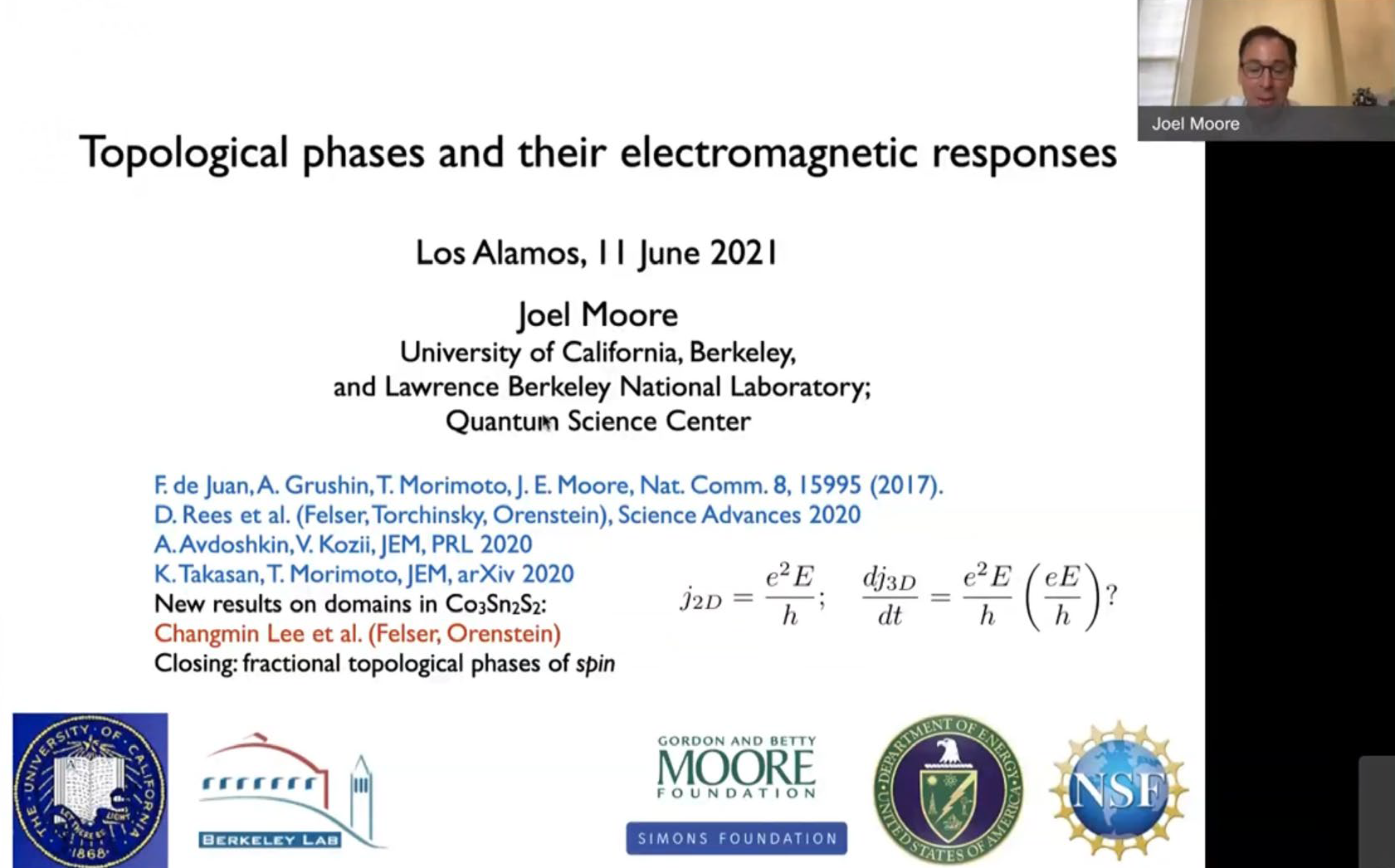 Joel Moore, University of California and Berkeley & Lawrence Berkeley National Lab, Distinguished Lectures Series on Topological Materials: Topological Phases and Their Electromagnetic Responses, June 11, 2021 talk, Video Link, WebEx.
Joel Moore, University of California and Berkeley & Lawrence Berkeley National Lab, Distinguished Lectures Series on Topological Materials: Topological Phases and Their Electromagnetic Responses, June 11, 2021 talk, Video Link, WebEx.
Abstract: This talk starts by reviewing known examples of how topological materials generate new kinds of electrodynamic couplings and effects. Three-dimensional topological insulators realize a particular electromagnetic coupling known as “axion electrodynamics”, and understanding this leads to an improved understanding of magnetoelectricity in all materials. We then turn to how topological Weyl and Dirac semimetals can show unique electromagnetic responses; we argue that in linear response the main observable effect solves an old problem via the orbital moment of Bloch electrons, and how in nonlinear optics there should be a new quantized effect, which may have been seen experimentally. This nonlinear effect has a natural quantum e^3/h^2 and appears in chiral Weyl semimetals over a finite range of frequencies. We discuss interaction and disorder corrections to nonlinear responses in closing, which clarify the significant differences between topological responses in metals and insulators.
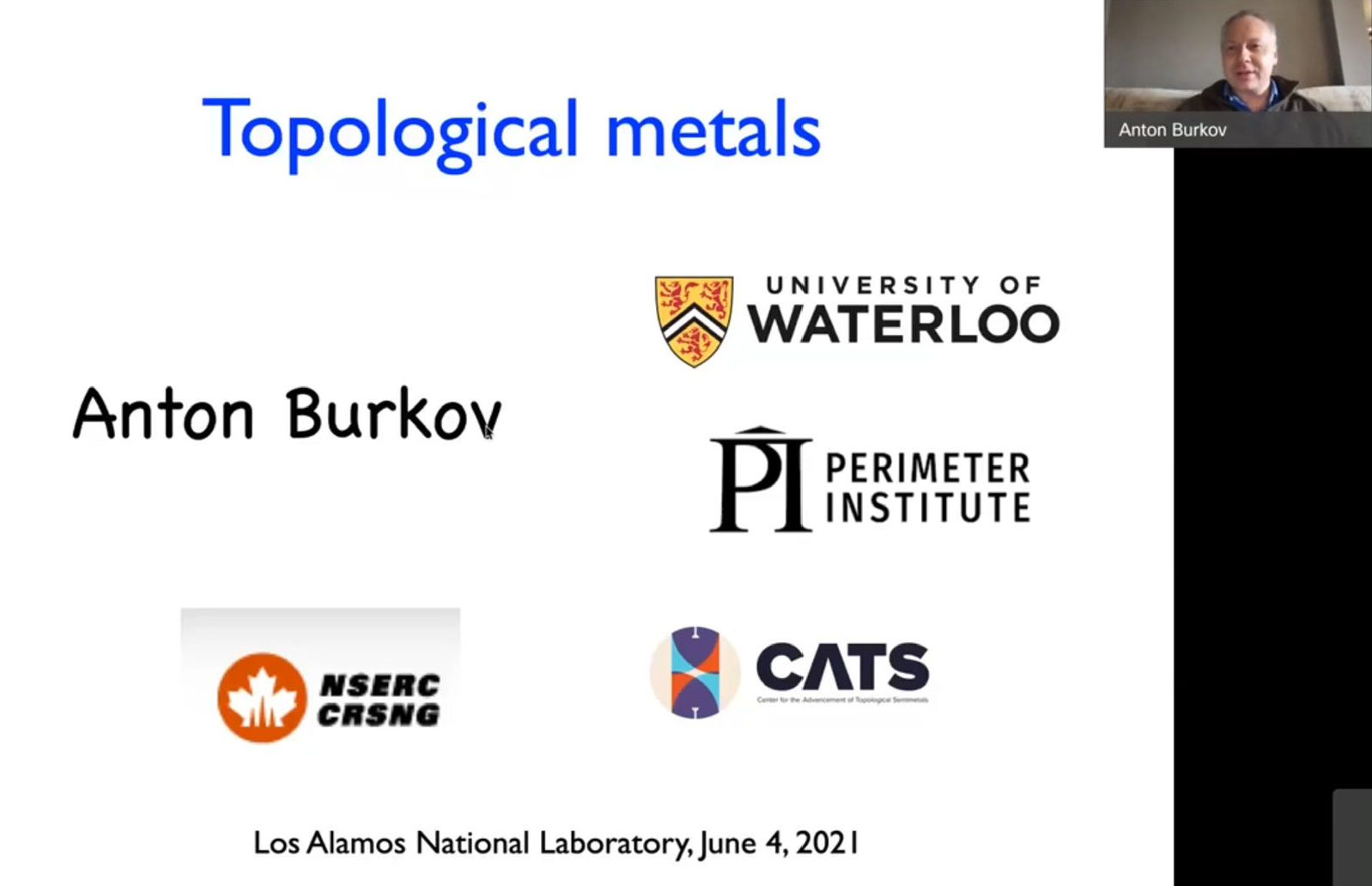 Anton Burkov, Professor at University of Waterloo and Associate Faculty at Perimeter Institute, Distinguished Lectures Series on Topological Materials: Topological Metals, June 4, 2021 talk, Video link WebEx.
Anton Burkov, Professor at University of Waterloo and Associate Faculty at Perimeter Institute, Distinguished Lectures Series on Topological Materials: Topological Metals, June 4, 2021 talk, Video link WebEx.
Abstract: One of the major themes of the modern condensed matter physics is the study of materials with nontrivial electronic structure topology. Particularly significant progress in this field has happened within the last decade, due to the discovery of topologically nontrivial states of matter, that have a gap in their energy spectrum, namely topological insulators and superconductors. In this talk I will describe the most recent work, partly my own, extending the notions of the nontrivial electronic structure topology to gapless states of matter as well, namely to semimetals and even metals. I will discuss both the theoretical concepts, and the recent experimental work, realizing these novel states of
condensed matter.
 Subir Sachdev, Herchel Smith Professor of Physics, Harvard University, Distinguished Lectures Series on Topological Materials: The SYK model: a window into non-Fermi liquids, May 28, 2021 talk, video link WebEx.
Subir Sachdev, Herchel Smith Professor of Physics, Harvard University, Distinguished Lectures Series on Topological Materials: The SYK model: a window into non-Fermi liquids, May 28, 2021 talk, video link WebEx.
Abstract: The SYK (Sachdev-Ye-Kitaev) model describes a many-body system of interacting fermions without quasiparticle excitations and“Planckian" time thermalization. After an introduction to the SYK model, I will apply insights from its solution to realistic models of “strange metals” found in numerous correlated electron compounds. I will also briefly mention the connection between the SYK model and the quantum theory of charged black holes.
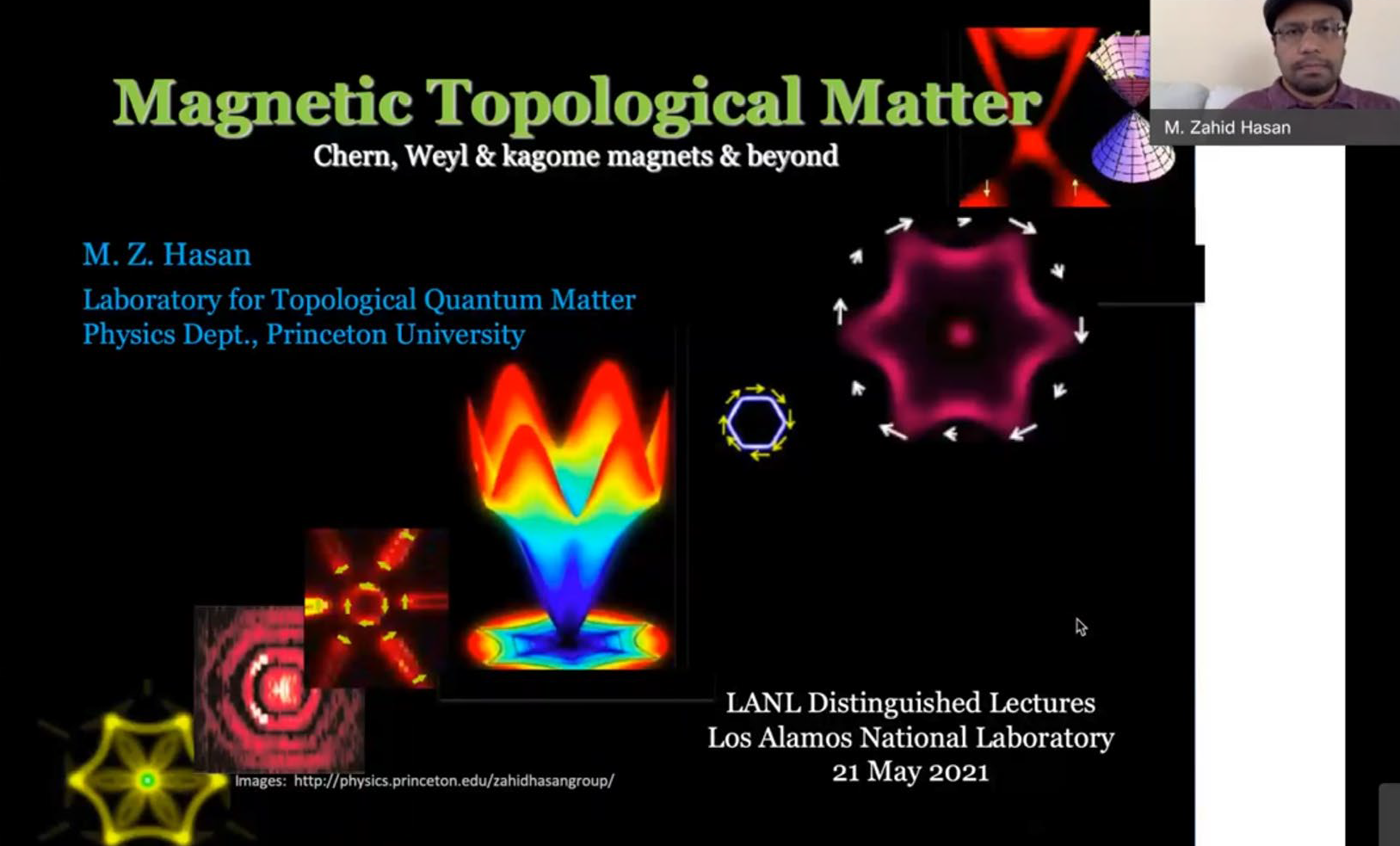 M.Zahid Hasan, Eugene Higgins Professor of Physics at Princeton University, Visiting Scientist at LBNL-Berkeley Friday, Distinguished Lectures on Topological Materials: Magnetic Topological Matter, May 21 talk, video link, WebEx.
M.Zahid Hasan, Eugene Higgins Professor of Physics at Princeton University, Visiting Scientist at LBNL-Berkeley Friday, Distinguished Lectures on Topological Materials: Magnetic Topological Matter, May 21 talk, video link, WebEx.
Abstract: Electrons organize in ways to give rise to distinct phases of matter such as insulators, metals, magnets, superfluid or superconductors. In the last ten years or so, it has become increasingly clear that in addition to the symmetry-based classification of matter, topological consideration of wavefunctions plays a key role in determining distinct or new quantum phases of matter [see, for an introduction, Hasan & Kane, Reviews of Modern Physics 82, 3045 (2010)].
In this talk, I briefly introduce these new topological concepts in the context of their experimental realizations in three dimensional magnetic matter. As examples, I present how tuning a topological insulator whose surface hosts an unpaired Dirac fermion can give rise to emergent Weyl fermion and “fractional” Fermi surfaces; and strongly correlated magnetic, Chern or many-body states of matter. These “magnetic
topological matter” harbor novel and unprecedented properties that may lead to the development of next generation quantum technologies.
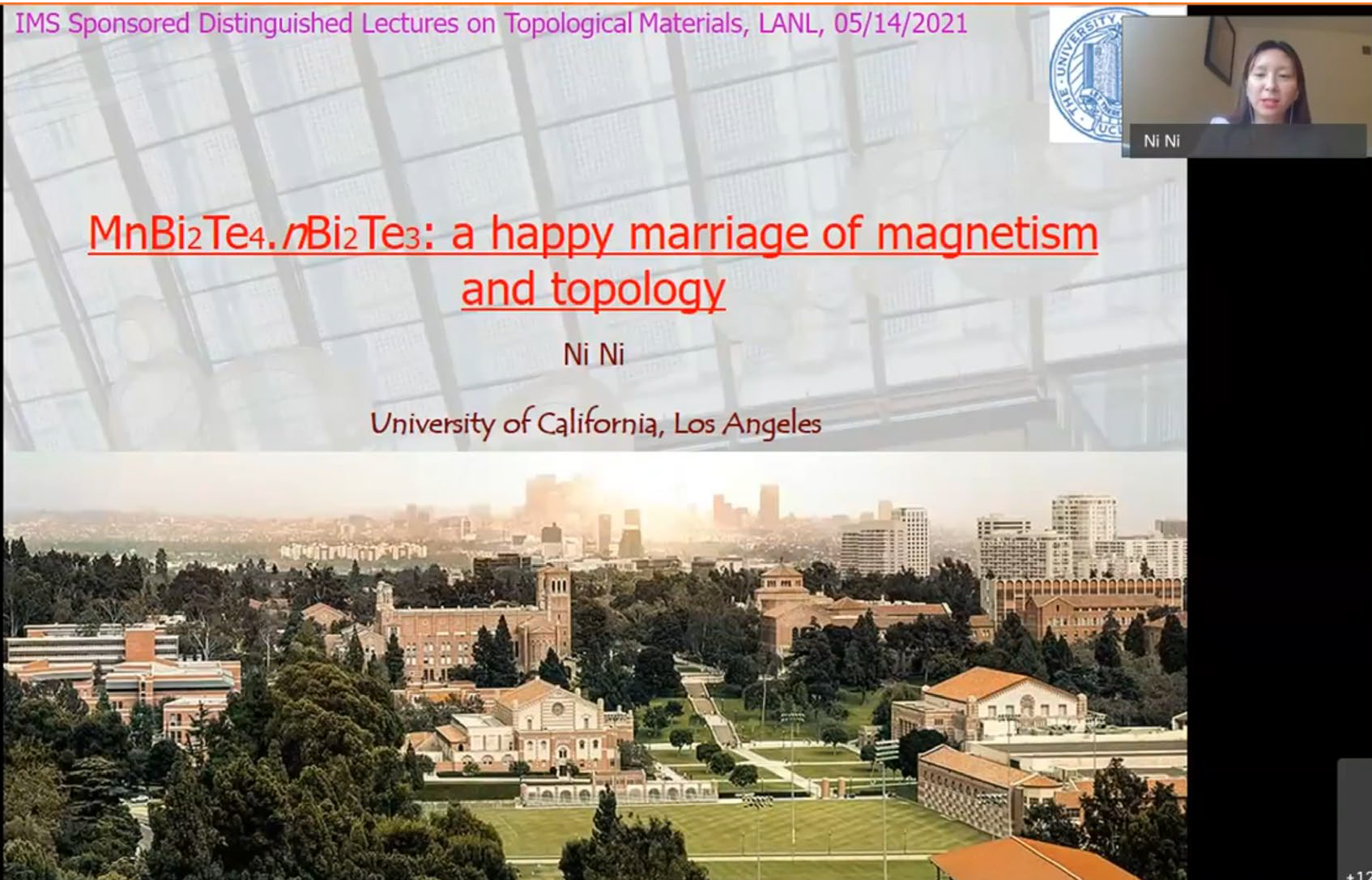 Ni Ni, Associate Professor of Physics & Astronomy University of California, Los Angeles, Distinguished Lectures on Topological Materials: MnBi2Te4.nBi2Te3: a happy marriage of magnetism and topology, May 14, 2021 talk, video link, WebEx.
Ni Ni, Associate Professor of Physics & Astronomy University of California, Los Angeles, Distinguished Lectures on Topological Materials: MnBi2Te4.nBi2Te3: a happy marriage of magnetism and topology, May 14, 2021 talk, video link, WebEx.
Abstract: Magnetic topological materials provide a great platform for discovering new topological states, such as the axion insulators, the Chern insulators, and the 3D quantum anomalous Hall (QAH) insulators. Recently, MnBi2Te4 was discovered to be the first material realization of an intrinsic antiferromagnetic topological insulator (TI) where the QAH effect was observed at a record high temperature in its two-dimensional limit. Since the interplay of the magnetism and band topology determines their topological nature, understanding and manipulating the magnetism inside magnetic TIs will be crucial. In this talk, I will present our discovery of two new magnetic topological materials MnBi2Te4.nBi2Te3 (n=1 and 3) which consist of alternating [MnBi2Te4] and n[Bi2Te3] layers. I will show that by reducing the interlayer magnetic coupling with the increasing number of spacer [Bi2Te3] layers, MnBi2Te4.nBi2Te3 can be tuned from Z2 antiferromagnetic TIs (n=0,1,2) to ferromagnetic axion insulators. Furthermore, I will show that a continuous fine control of the magnetism in MnBi4Te7 can be made by Sb doping, where an AFM to FM switching emerges due to the formation of the Mn/Sb antisite disorders. Our study provides a rare tunable material platform to investigate various emergent phenomena arising from the interplay of magnetism and band topology.
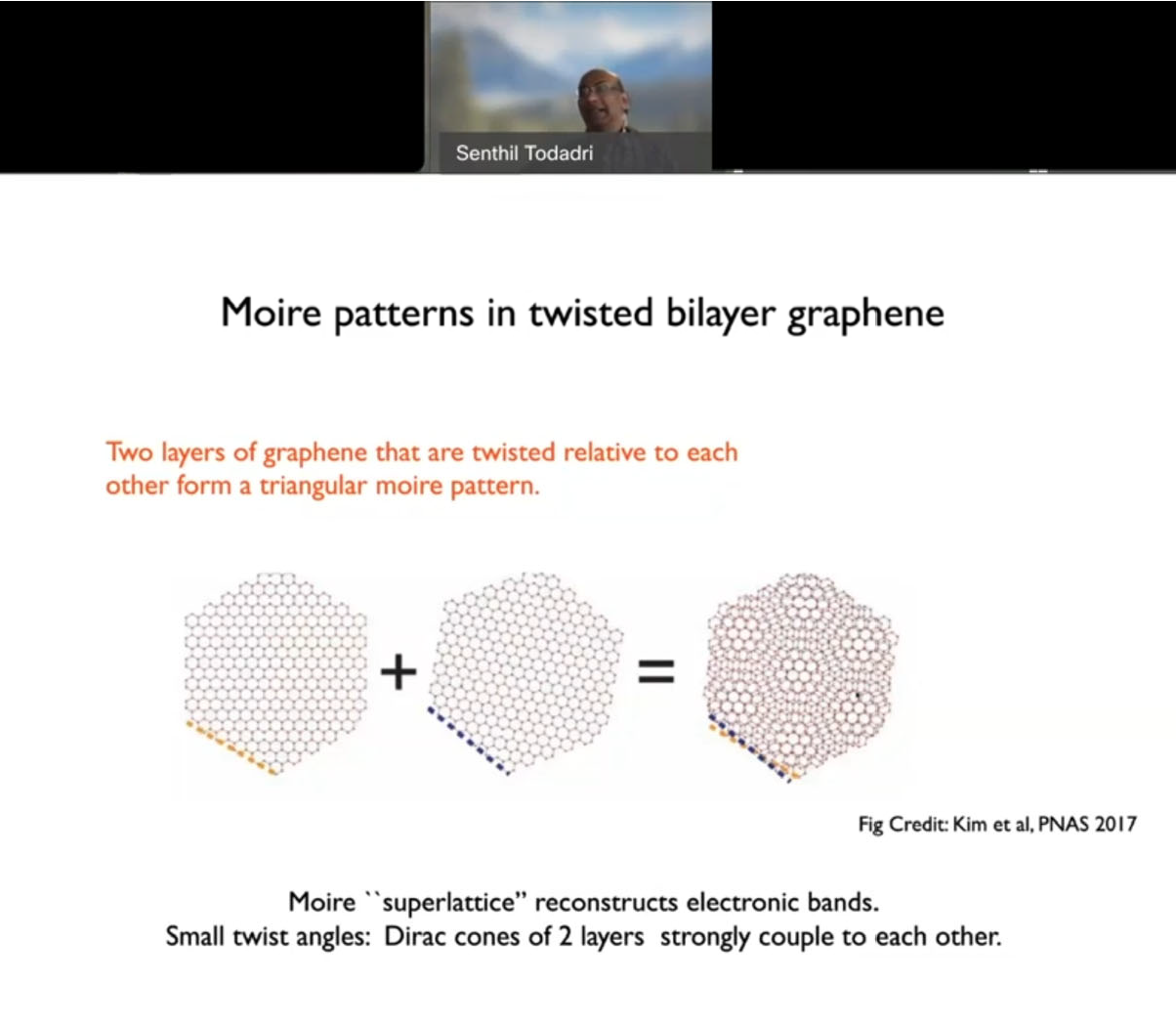 Senthil Todadri, Associate Professor of Physics, Massachusetts Institute of Technology, Distinguished Lectures Series on Topological Materials: Correlations and topology in graphene Moire lattices, April 16, 2021 talk, Video Link, WebEx.
Senthil Todadri, Associate Professor of Physics, Massachusetts Institute of Technology, Distinguished Lectures Series on Topological Materials: Correlations and topology in graphene Moire lattices, April 16, 2021 talk, Video Link, WebEx.
Abstract: A remarkable recent development is the discovery of correlated electronic states in twisted bilayer graphene and other Moire graphene systems. In this talk I will discuss aspects of the theory of these systems. I will show that both strong correlations and band topology are features of many graphene Moire lattices. I will discuss interesting questions for many body physics that arise in this context and will answer some of them.
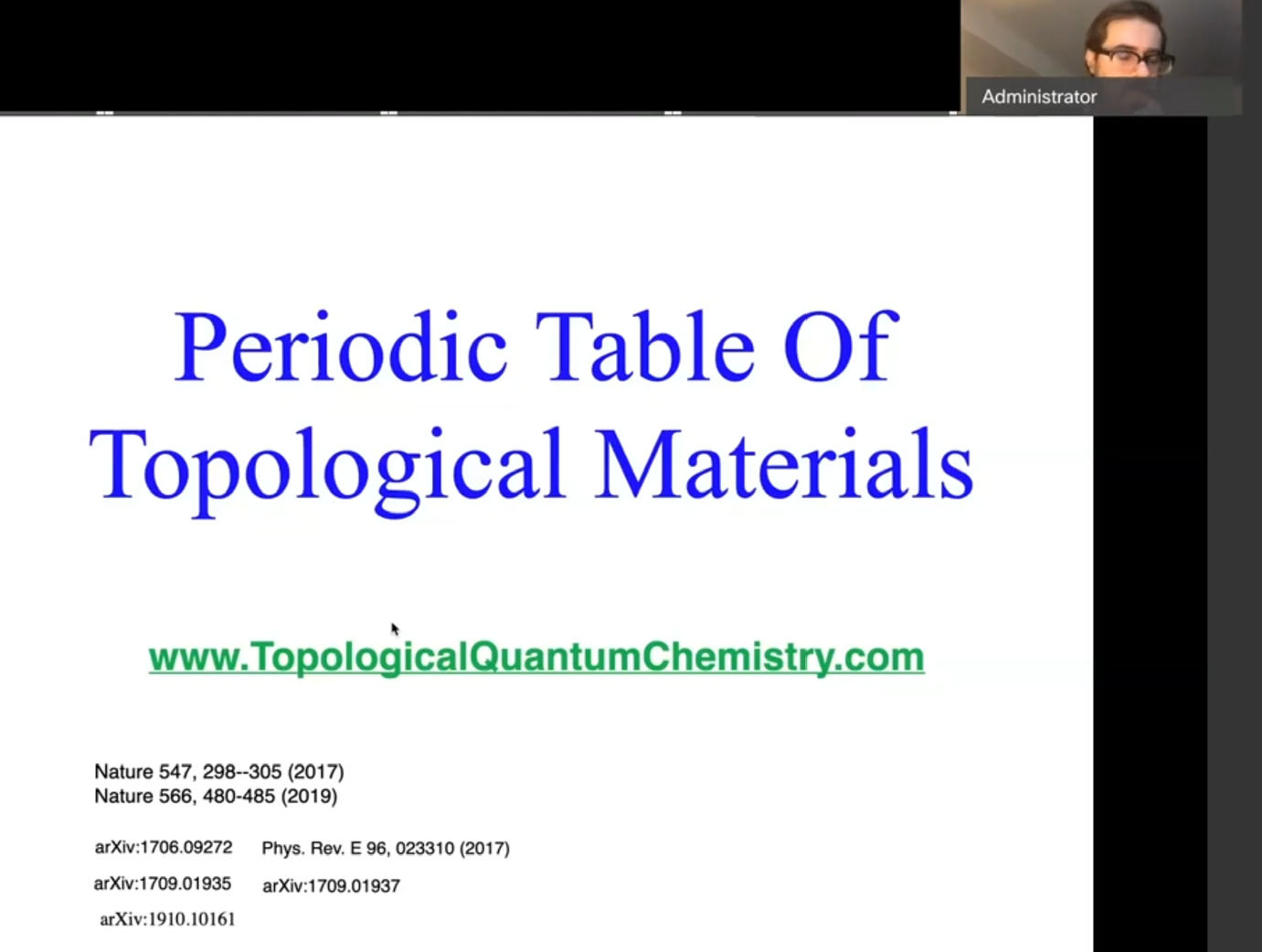 Andrei Bernevig, Professor of Physics, Princeton University, Distinguished Lectures Series on Topological Materials: Topological Quantum Chemistry and the Topological Periodic Table of Magnetic and Nonmagnetic Materials, April 9, 2021 talk, Video Link, WebEx.
Andrei Bernevig, Professor of Physics, Princeton University, Distinguished Lectures Series on Topological Materials: Topological Quantum Chemistry and the Topological Periodic Table of Magnetic and Nonmagnetic Materials, April 9, 2021 talk, Video Link, WebEx.
Abstract: One newly discovered characterization of insulators, metals and semimetals is based on their topological properties. Topological insulators do not conduct in the bulk but, unlike their non- Topological counterparts, exhibit perfect conduction on their surface. Topological metals conduct in the bulk, but, unlike their non-Topological counterparts cannot be gapped due to a special type of protection that allows their low energy electrons to exhibit esoteric phenomena such as chiral anomaly or non-local transport. It was initially thought that the materials exhibiting these phenomena are very special and unique amongst all of the 140000 compounds known to humankind. We will present a review of these ideas and properties of topological materials. We will then show how, using a Topological Quantum Chemistry, we are able to now catalogue a large subset (35000) of all the topological materials that can possibly exist in nature. We then apply our theory to find that more than 40% of all known compounds - including some of the most interesting materials in nature - are actually topological. We hence live in a topological world! We will give examples of new states, including fragile states, twisted Moire patterns, and hinge arcs, that have all been discovered to exhibit topological properties.
 Liang Fu, Dept. of Physics, Massachusetts Institute of Technology, From Nonlinear Hall Effect to Topological Optoelectronics, April 2, 2021 talk, Video Link, WebEx.
Liang Fu, Dept. of Physics, Massachusetts Institute of Technology, From Nonlinear Hall Effect to Topological Optoelectronics, April 2, 2021 talk, Video Link, WebEx.
Abstract: I will describe recent theories and experiments on nonlinear Hall effect in quantum materials at zero magnetic field, where an applied electric field induces a transverse current at second order. This effect arises from anomalous velocity due to current-induced Berry curvature in inversion-breaking systems. Large nonlinear Hall effect has been found in topological materials, and opens a new path for terahertz/infrared photodetection and energy harvesting applications.
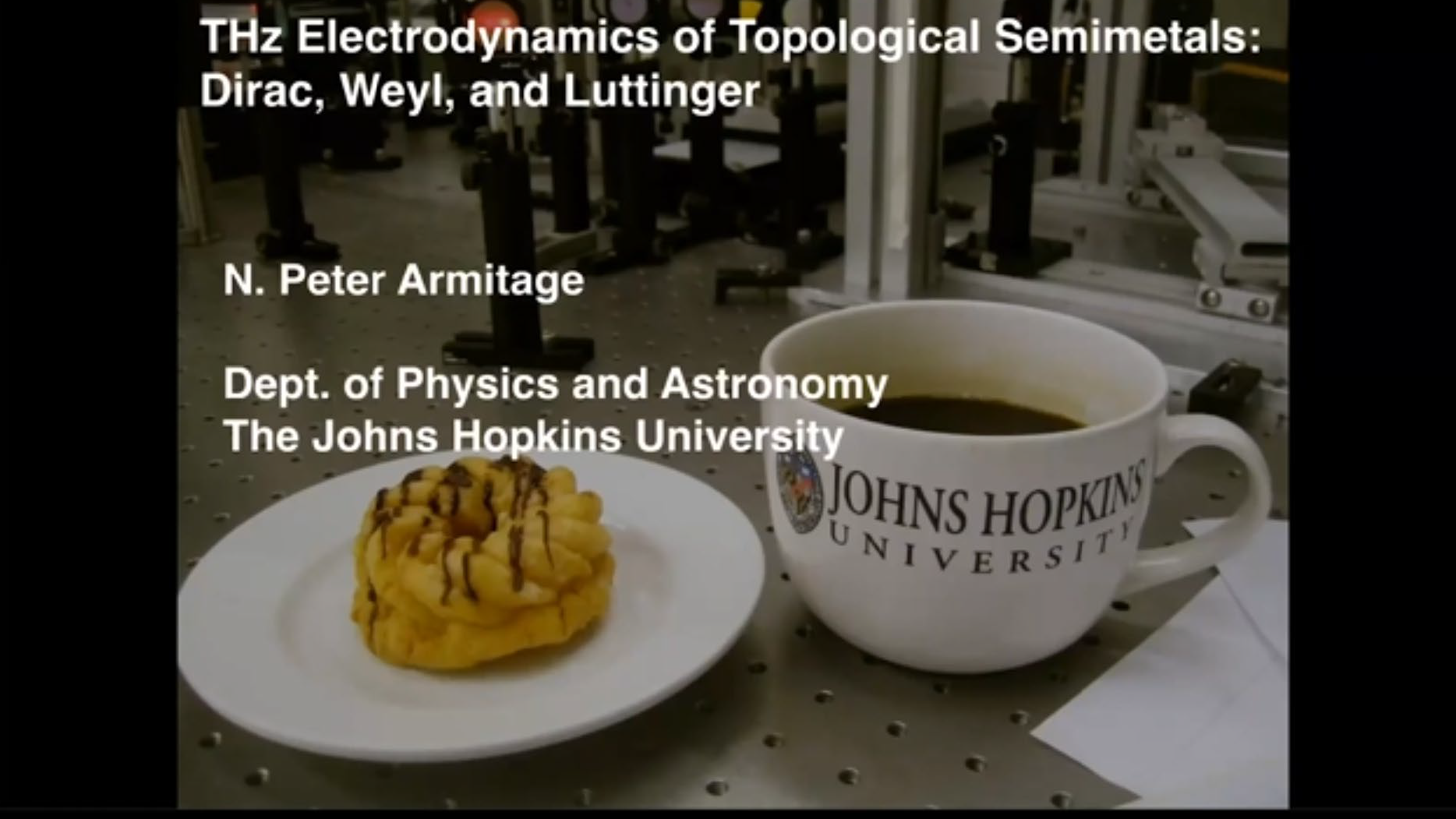 N. Peter Armitage, Dept. of Physics and Astronomy, The Johns Hopkins University, Distinguished Lectures Series on Topological Materials, Recent results on the electrodynamics of topological semimetals: Mn3Sn, Cd3As2, Pr2Ir2O7 and beyond… March 5, 2021 talk, Video Link, WebEx.
N. Peter Armitage, Dept. of Physics and Astronomy, The Johns Hopkins University, Distinguished Lectures Series on Topological Materials, Recent results on the electrodynamics of topological semimetals: Mn3Sn, Cd3As2, Pr2Ir2O7 and beyond… March 5, 2021 talk, Video Link, WebEx.
Abstract: One of the remarkable and continuing themes in physics is that concepts and mathematical structures are repeated in different contexts across vastly different length scales. Almost 90 years ago the Dirac and Weyl equations were proposed in the first successful reconciliation of special relativity and quantum mechanics. In condensed matter physics, where one is interested in energy scales much smaller than the rest mass of the electron, it would appear that a nonrelativistic description, perhaps with minor corrections, would suffice and that Dirac physics would not play an important role. It is therefore remarkable that in recent years a number of actual real materials exist in which the propagation of even slow electrons through the periodic potential of a crystal leads to a an effective low-energy description that can resemble the Dirac and Weyl equations. In this talk I will review our recent work using on the electrodynamic response of these topological semimetals. I will discuss magnetic Weyl systems, Dirac semimetals, “massive” Dirac systems and systems that even go beyond that possible in free space in the form of a Luttinger semimetal e.g. a quadratic band touching. These systems show a number of fascinating electronic and electromagnetic properties including zero energy Landau levels, the chiral anomaly, anomalous coupling of cyclotron motion to phonons that renders the phonons circularly polarized, and in the case of the quadratic band touchings -- strong interactions.
 Maria A.H. Vozmediano, Instituto de Ciencia de Materiales de Madrid, Spanish National Research Council (CSIS), Distinguished Lectures Series on Topological Materials: Axial gauge fields and new anomaly induced transport in Dirac matter, February 26, 2021 talk, Video Link, WebEx.
Maria A.H. Vozmediano, Instituto de Ciencia de Materiales de Madrid, Spanish National Research Council (CSIS), Distinguished Lectures Series on Topological Materials: Axial gauge fields and new anomaly induced transport in Dirac matter, February 26, 2021 talk, Video Link, WebEx.
Abstract: The coupling of lattice deformations to electronic properties in graphene -- the most popular Dirac material -- as gauge fields has given rise to a vast field of theoretical and experimental results, as well as applications. Weyl semimetals were synthesized in 2015. Although they can be seen as 3D graphene, a series of new phenomena arise from the fundamental differences between chiral fermions in two and three dimensions. Chiral imbalance in 3D implies a set of anomalies related transport phenomena first discussed in the context of high energy collisions (quark-gluon plasma) [1]. In this talk we will see some of the implications of these phenomena to the novel Dirac materials. I will explain the origin of the anomaly-induced response functions and review the experimental evidences found so far. Finally I will describe novel response functions associated to the axial gauge fields and to the scale anomaly in Dirac and Weyl semimetals [2]. I will try to be pedagogical in my presentation.
[1] The Chiral Magnetic Effect and Anomaly-Induced Transport, Dmitri E. Kharzeev, arXiv:1312.3348. [2] Strain induced Chiral Magnetic Effect in Weyl semimetals, Alberto Cortijo, Dmitri Kharzeev, Karl Landsteiner and María A.H. Vozmediano, Phys. Rev. B 94, 241405(R),(2016). - Generation of a Nernst current from the conformal anomaly in Dirac and Weyl semimetals, Maxim N. Chernodub, Alberto Cortijo, and M. A. H. Vozmediano, Phys. Rev. Lett. 120, 206601 (2018). - Detect Axial Gauge Fields with a Calorimeter, Matteo Baggioli, Maxim Chernodub, Karl Landsteiner, and María A.H. Vozmediano, SciPost Phys. Core 3, 013 (2020).
